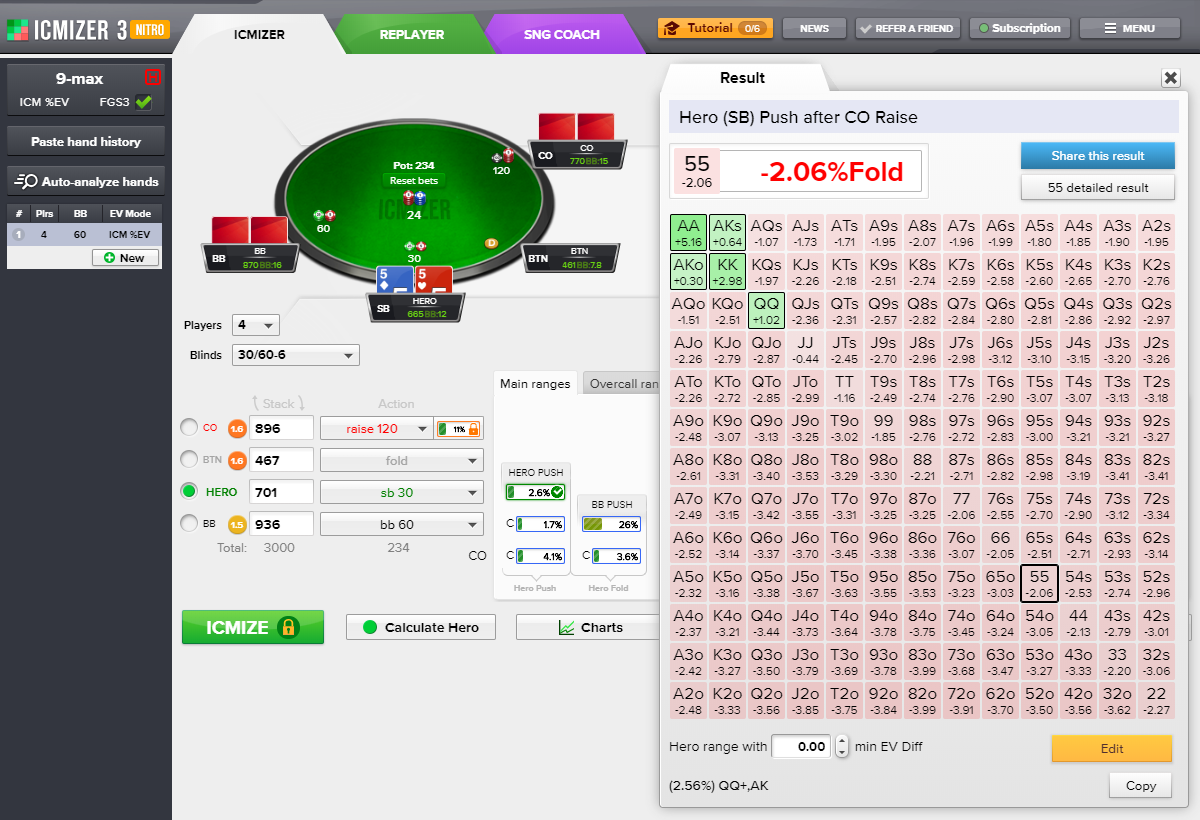There are good ways to use ICMIZER and there are bad ones. By avoiding the typical mistakes, you can not only save time but also ensure you’re making the best decisions in the tournaments you play.
Without further ado, here are the six biggest traps you should never fall into after you’re done reading.
1. Analyzing МТТs in Chip EV mode
Chip EV is a simplified analysis mode, because when the player folds, their fold equity does not depend on their opponents’ actions – it is simply equal to their stack size. When you select Chip EV mode for any tournament, ICMIZER calculates everything in chips only, ignoring tournaments payouts and knockout bounties. The calculations are performed in chips based on normal pot odds, like in a cash game.
Solution? Use ICM %EV or ICM $EV instead.
Chip EV calculations produce inaccurate results for multitable tournaments. This effect is less pronounced for large tournaments and their very early stages. But if a regular MTT starts with a field of less than 500, or if it has fewer than 500 players at some point (2,500 for Progressive Knockout tournaments), you should definitely opt for МТТ tournament type with ICM. This will allow you to craft a far more accurate strategy than with Chip EV.
Example:
$4.50 + $0.50 MTTSNG Turbo tournament, field of 180, 27 paid places, 28 players remaining, bubble.
200/400-50 blinds, 7 players at the table
UTG: 10,000
MP: 5,000
HIJ: 11,000
CO: 7,000
Hero (BTN): 3,000
SB: 8,000
BB: 10,000
Preflop: Hero is on the BTN with 99
UTG folds, MP raises 5,000 and is all in. What is the Hero’s best move?
Here is the result of a Chip EV calculation for this situation:
https://www.icmpoker.com/icmizer/#SkuPGn
As you can see, the Chip EV model ignores the tournament payout structure and the specifics of this tournament stage. It recommends calling the short-stacked MP’s push on the bubble with 99.
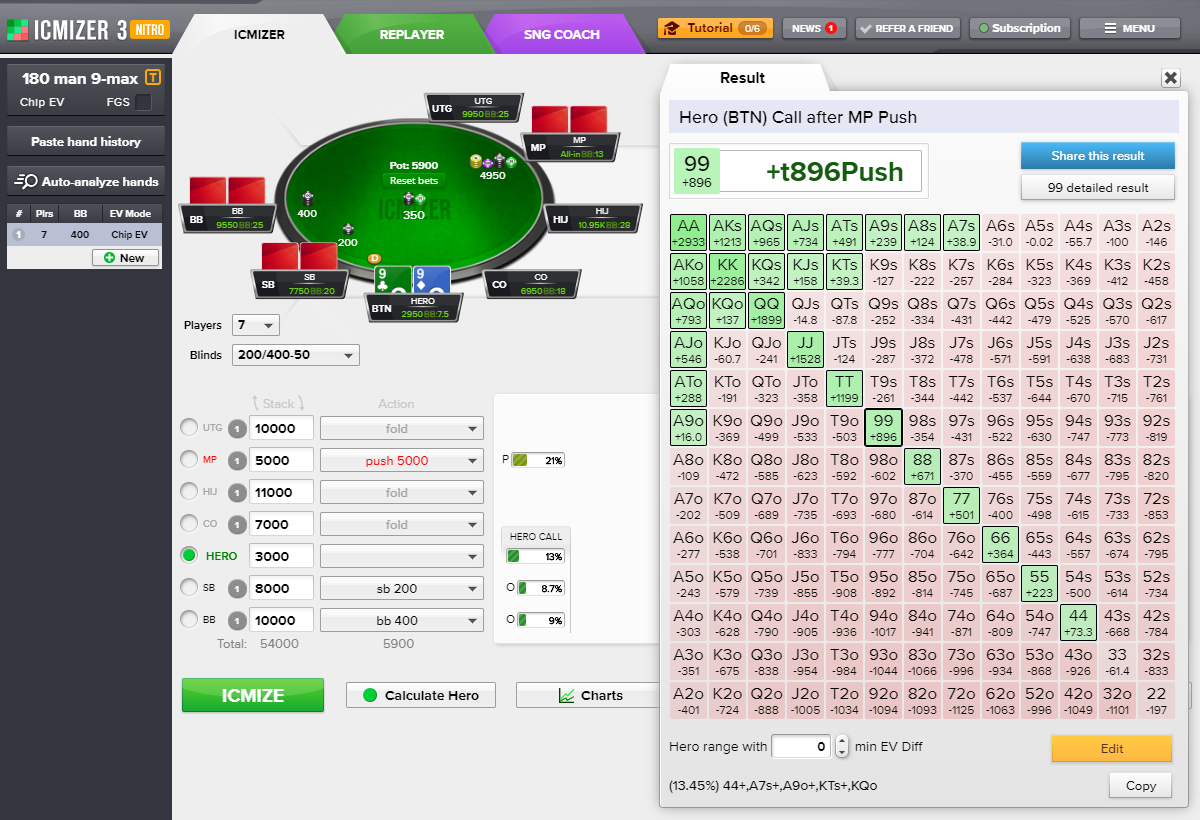
Now let’s do another calculation with ICM $EV. We set the prize pool to $810, select МТТ mode and enter 28 players remaining.
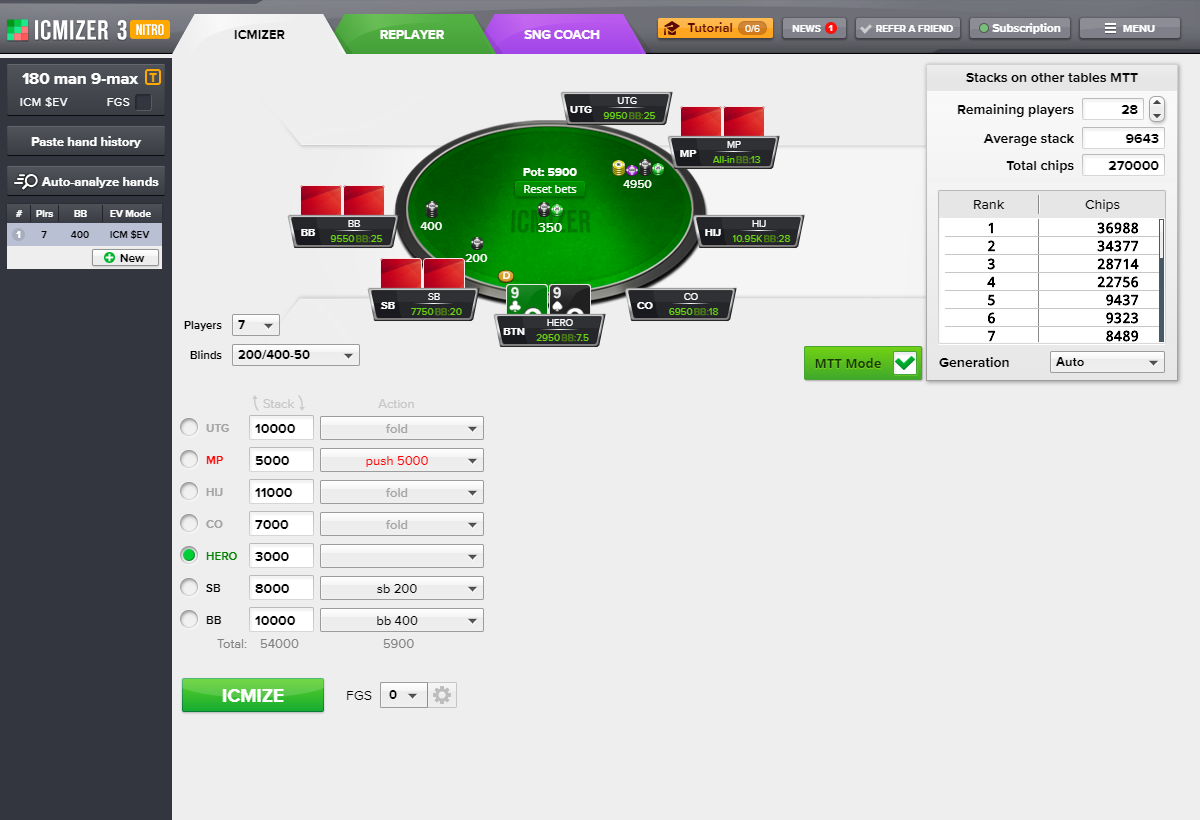
Here is the result of that ICM $EV calculation:
https://www.icmpoker.com/icmizer/#StvzJb
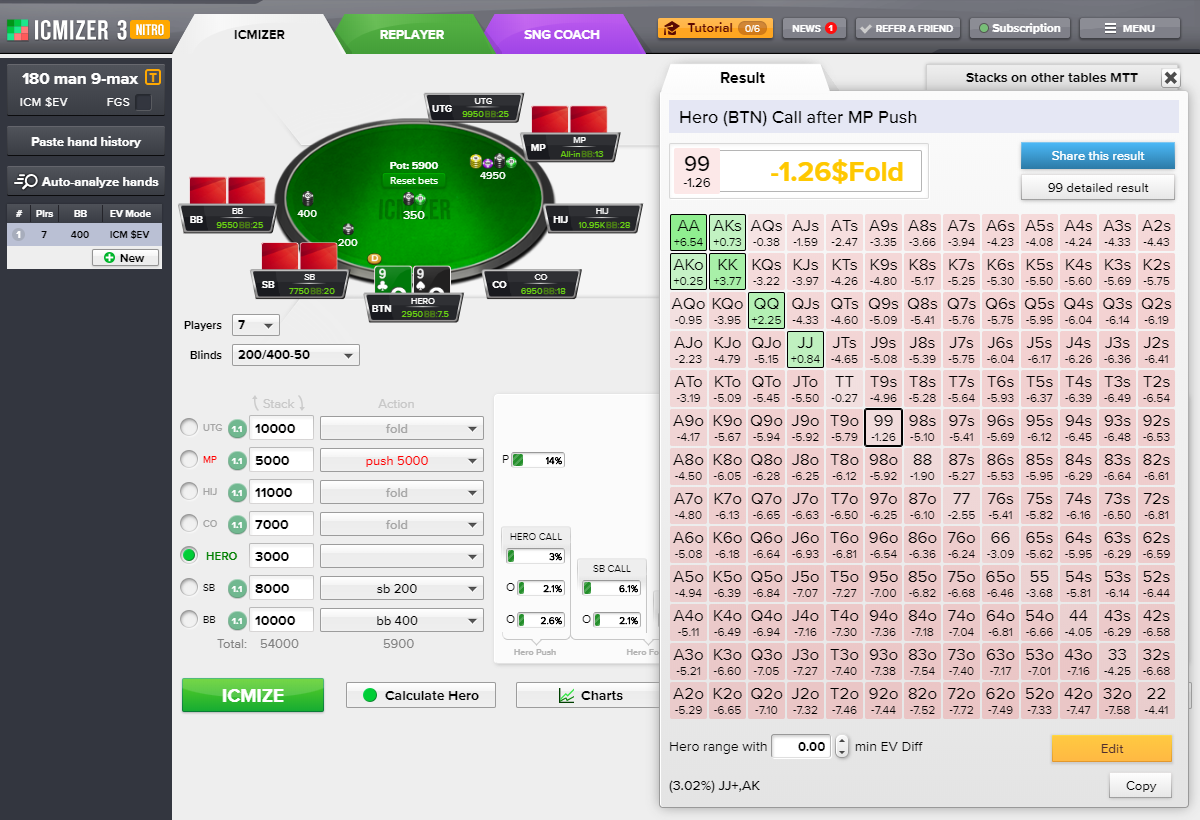
The ICM-based calculations fully and accurately reflect the tournament context and our intuitive expectations. That is, on the bubble we don’t have enough equity to call with 99; instead we should fold and keep our chances of finishing in the money, among the top 27.
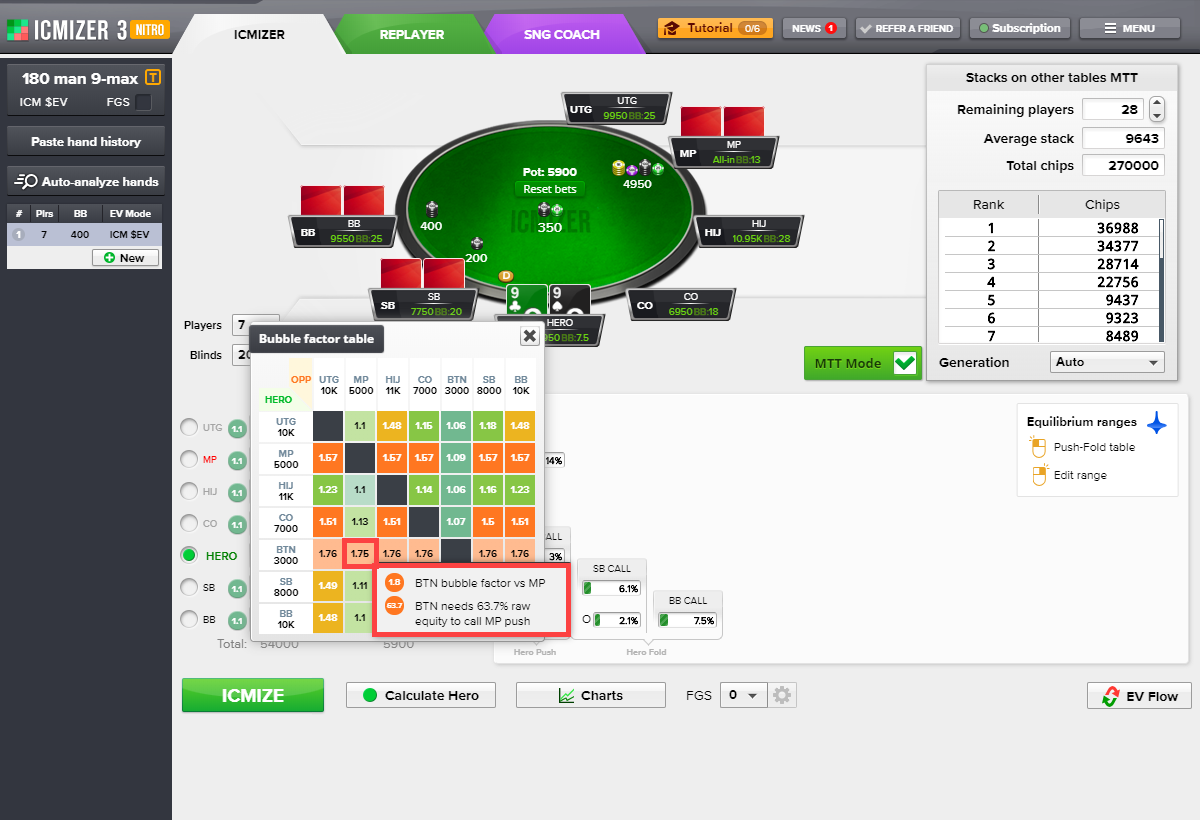
2. Choosing the wrong tournament structure
2. Choosing the wrong tournament structure
The ICM algorithm is a mathematical function of two variables – payout structure and player stack sizes. Knowing these inputs is enough to determine one’s ICM EV. But if you enter one of these crucial inputs incorrectly – the tournament’s payout structure – then the calculation results will be off.
The ICM algorithm accepts as input two arrays, or sets, of numbers: one with the prize amounts for each paid place, and the other with the players’ stack sizes. The outcome is another set of numbers which stand for each player’s tournament equity.
To calculate a tournament hand accurately, it is very important to select the right tournament payout structure and whether it has bounties (regular tournament, bounty tournament, or progressive bounty tournament).
ICMIZER comes with most poker rooms’ popular tournament structures available for you to choose from. If it doesn’t have the tournament type you need to analyze, you can easily create a custom tournament.
Let’s look at a typical example of a calculation performed with the wrong tournament structure.
Suppose we’ve loaded the following hand:
Fifty50 10-max Turbo
125/250-30 blinds, 6 players at the table
UTG: 2,645
HIJ: 1,200
CO: 2,530
BTN: 4,817
Hero (SB): 1,710
BB: 2,098
Preflop: Hero is on the SB with AJs
UTG folds, HIJ raises 1,200 and is all in, CO calls, BTN folds. What is the Hero’s best move?
This is the table ICMIZER generates:
https://www.icmpoker.com/icmizer/#hfCwlI
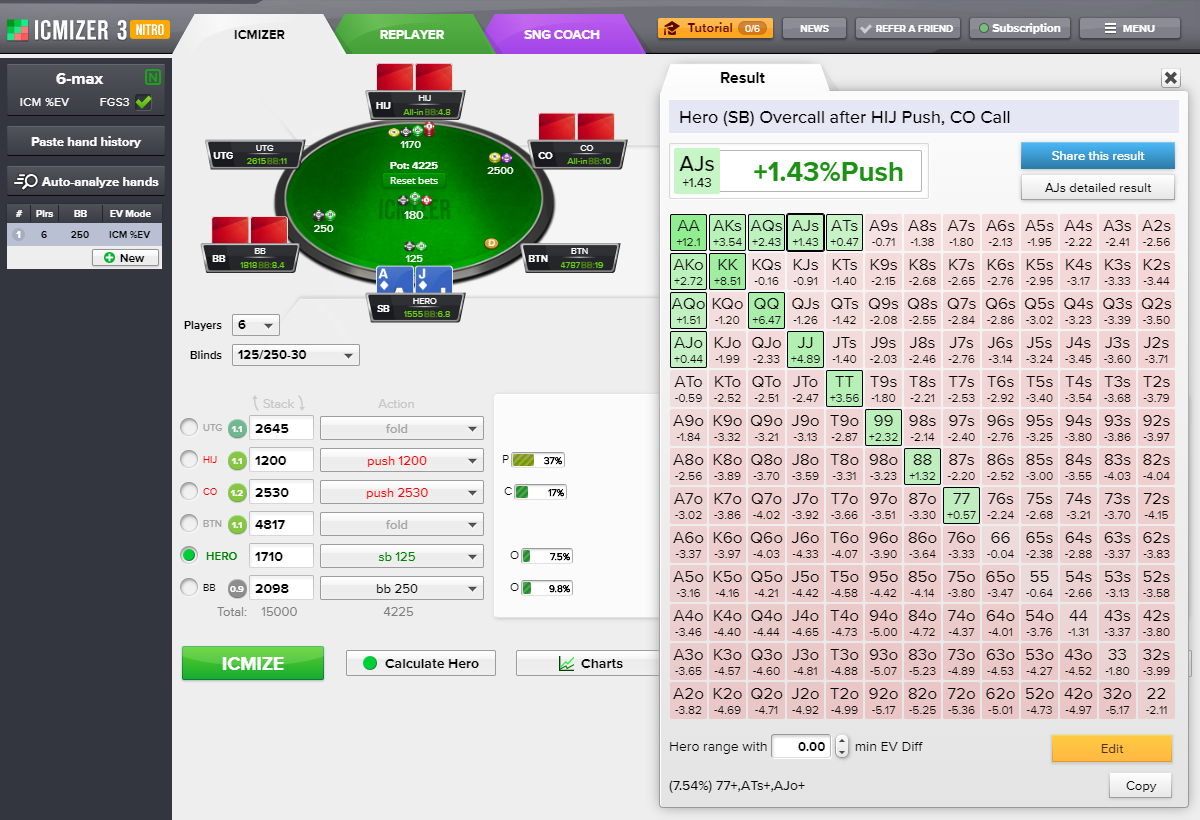
We can see that the Hero’s calling range against the two pushes from HIJ and CO is 7.5%, and the profit of his AJs call is displayed as +1.43% of the prize fool.
Note, however, that we did not choose the appropriate tournament payout structure before running this calculation. This means ICMIZER did the numbers for a 6-max SNG, where there are just two prizes, for first and second places.
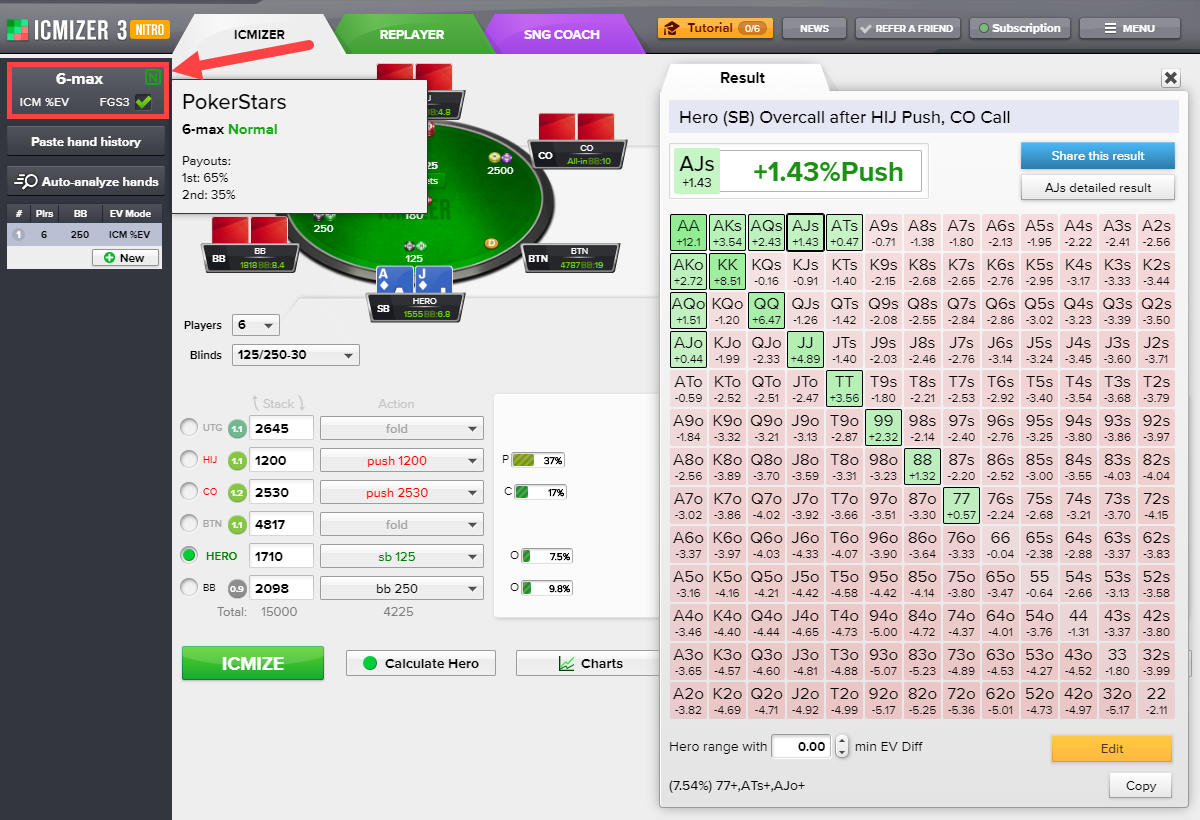
Let’s choose the correct structure – Fifty50 10-max Turbo – and see what the results look like this time:
https://www.icmpoker.com/icmizer/#hoDgow
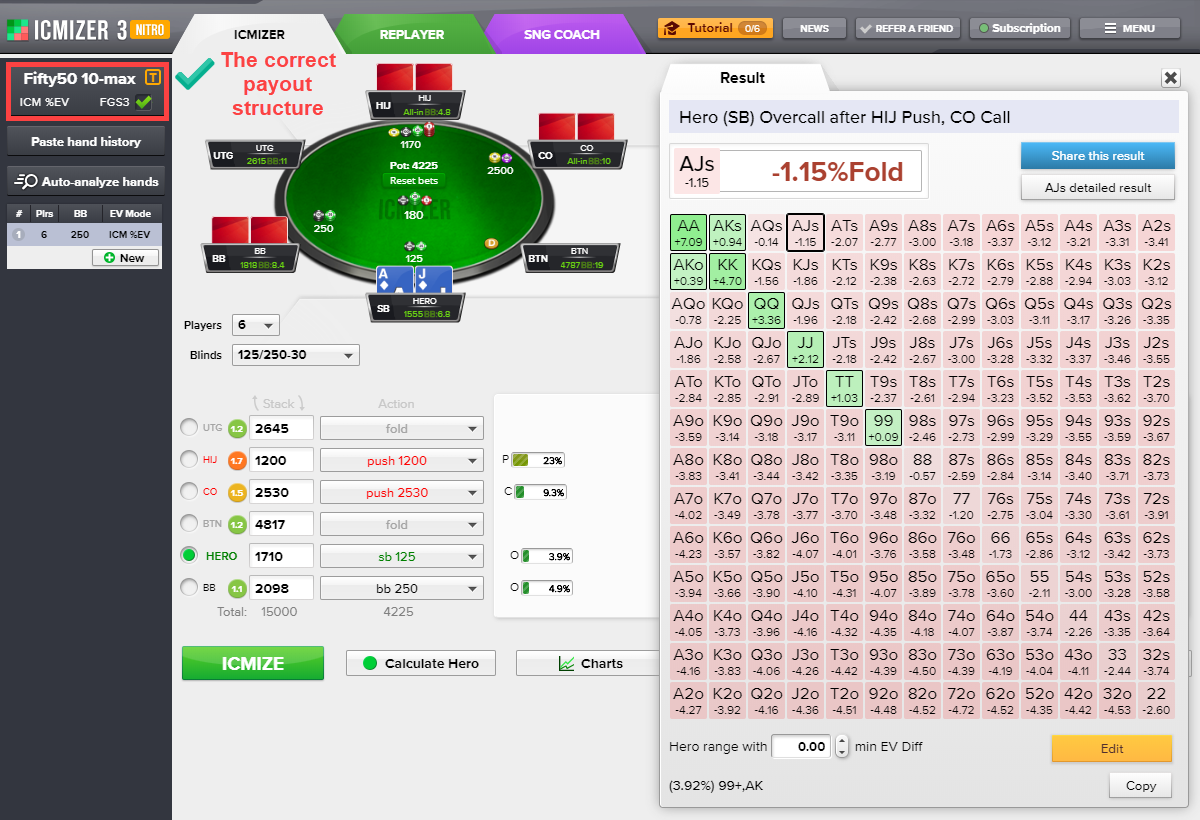
With the right structure taken into account, the Hero’s optimal range when calling two pushes from HIJ and CO is 3.9% – not 7.5% as previously calculated. What’s more, the profit of their call is actually negative at –1.15% of the tournament prize pool.
We hope this comparison makes it clear how choosing the wrong tournament payout structure can lead you astray.
Let’s consider one more example. Say, you are calculating a hand from an МТТ and the list of preset payout structures doesn’t have any that match your МТТ. If this happens, you should create a custom tournament type to ensure ICMIZER gives you the most accurate calculations and advice.
But for purposes of this post, let’s see what happens if you don’t. We’ll create a hand from a tournament with 936 players, starting stack of 10,000, and the following payouts for places 1 through 188:
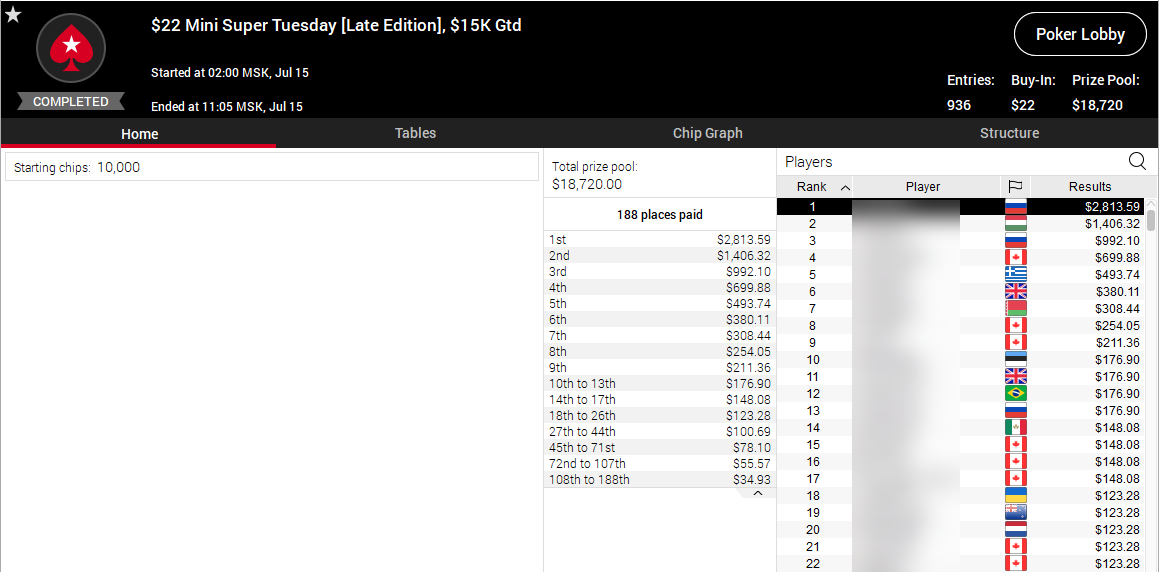
By the time this hand was played, there were 190 players remaining.
1K/2K–0.2K blinds, 9 players at the table:
UTG: 50,000
UTG1: 20,000
MP: 40,000
MP1: 25,000
HIJ: 90,000
CO: 45,000
BTN: 41,000
SB: 33,000
Hero (BB): 25,000
Preflop: Hero on the BB with TT
UTG folds, UTG1 folds, MP folds, MP1 raises 25,000 and is all in. The others before the Hero all fold. What is the Hero’s best move?
Instead of creating a custom tournament type, we choose one of the available preset payout structures that partially matches the tournament size – 1050-man Normal.
Here’s what we get:
https://www.icmpoker.com/icmizer/#WKMRao
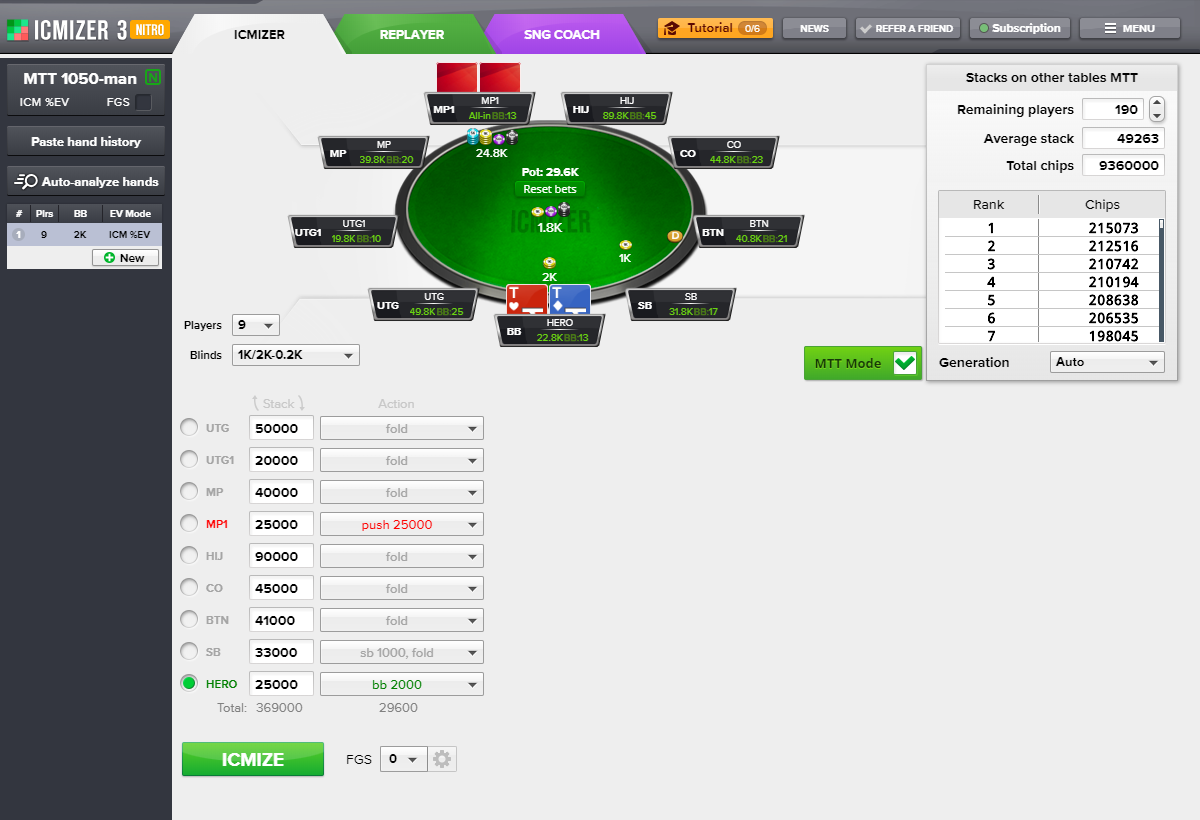
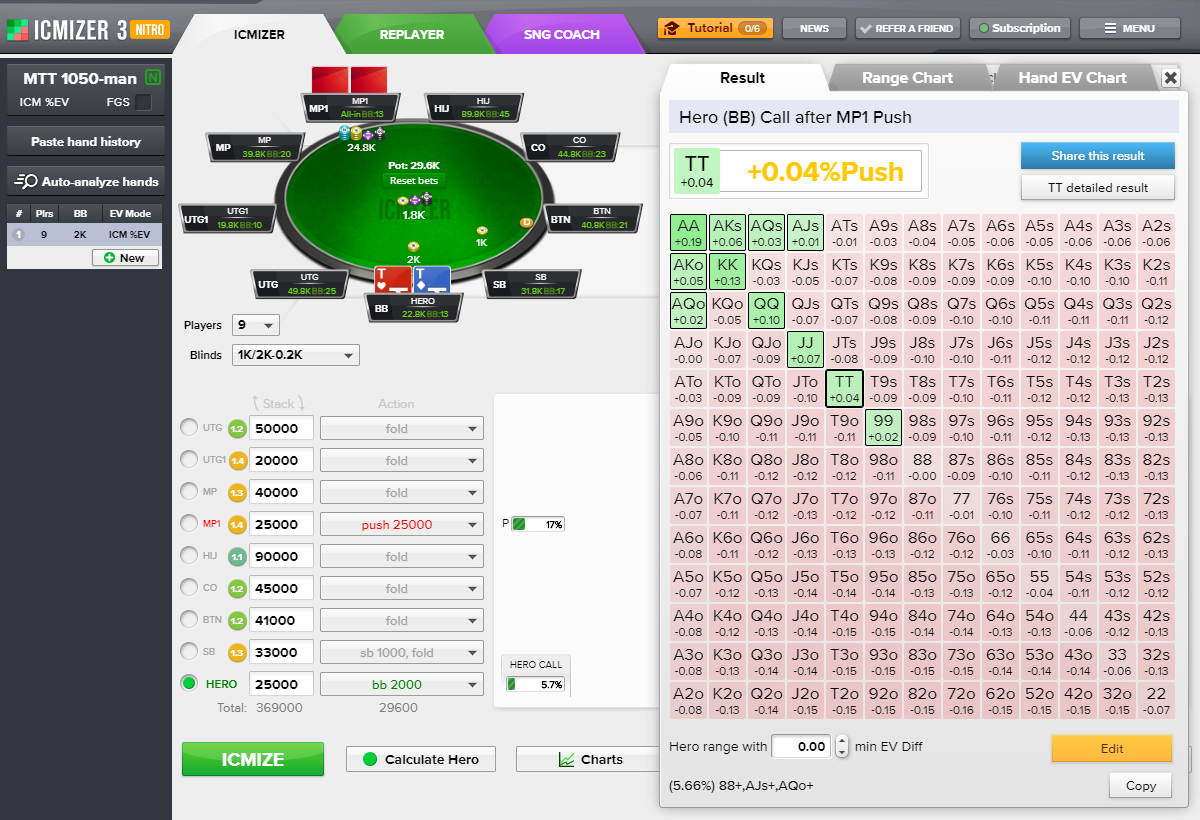
The Hero’s calling range against MP1’s push is shown as 5.7%, and the profit of his call with TT +0.04% of the prize pool.
Now let’s remember our tournament pays 188 top places, not 135 like this preset 1050-man Normal tournament does.
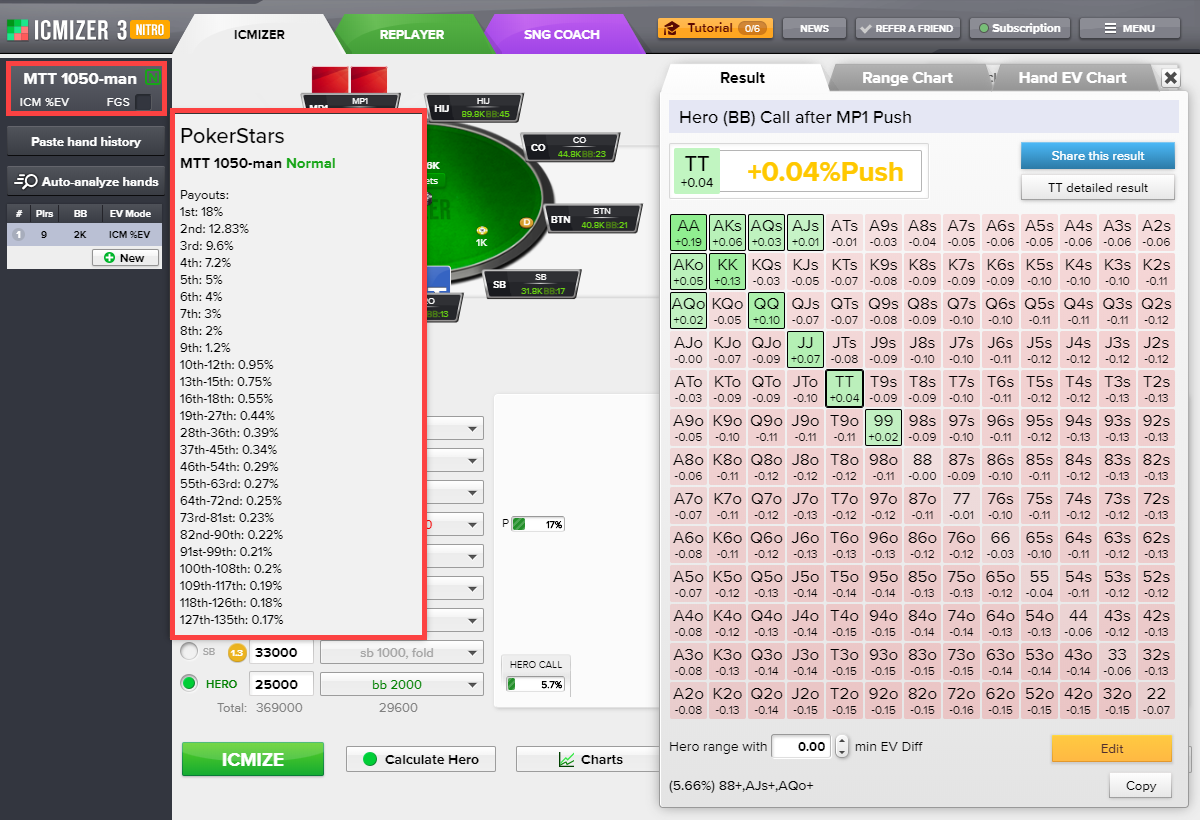
Let’s create a new tournament type to reflect this payout structure and see if that changes anything:
https://www.icmpoker.com/icmizer/#WBMgXA
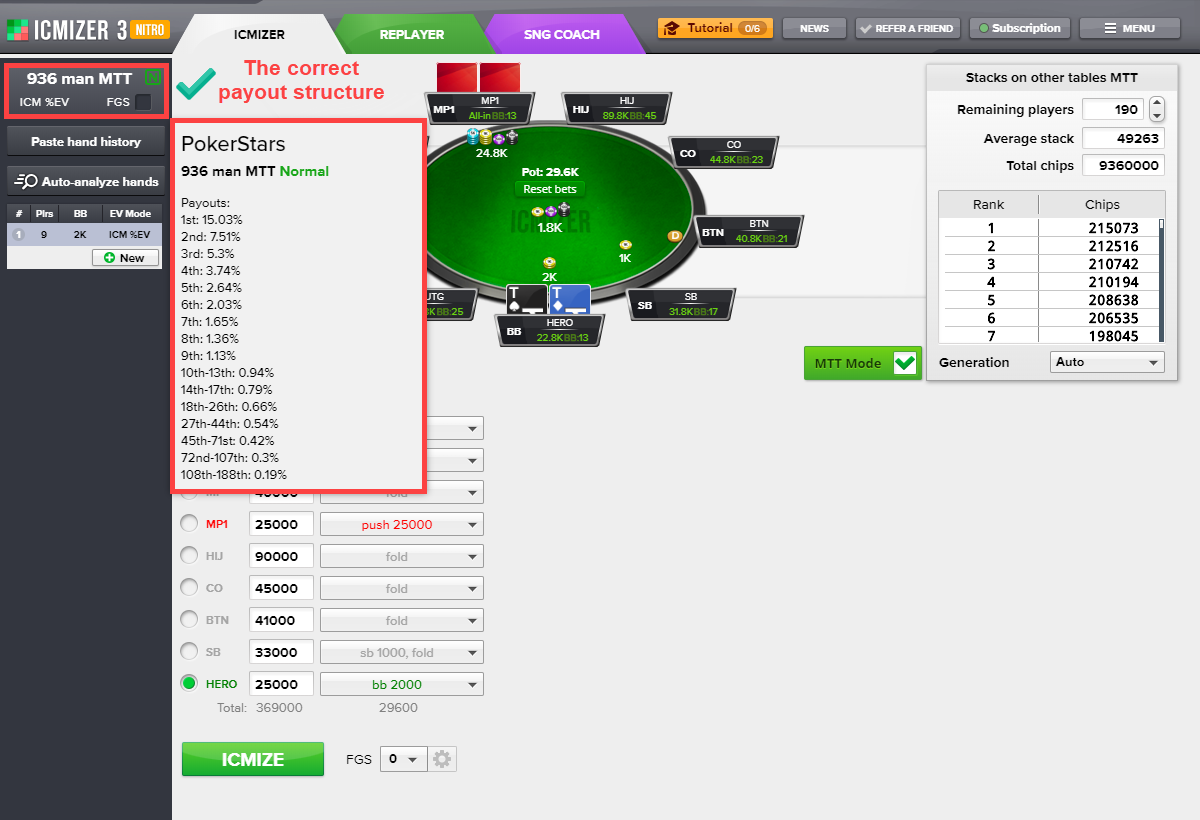
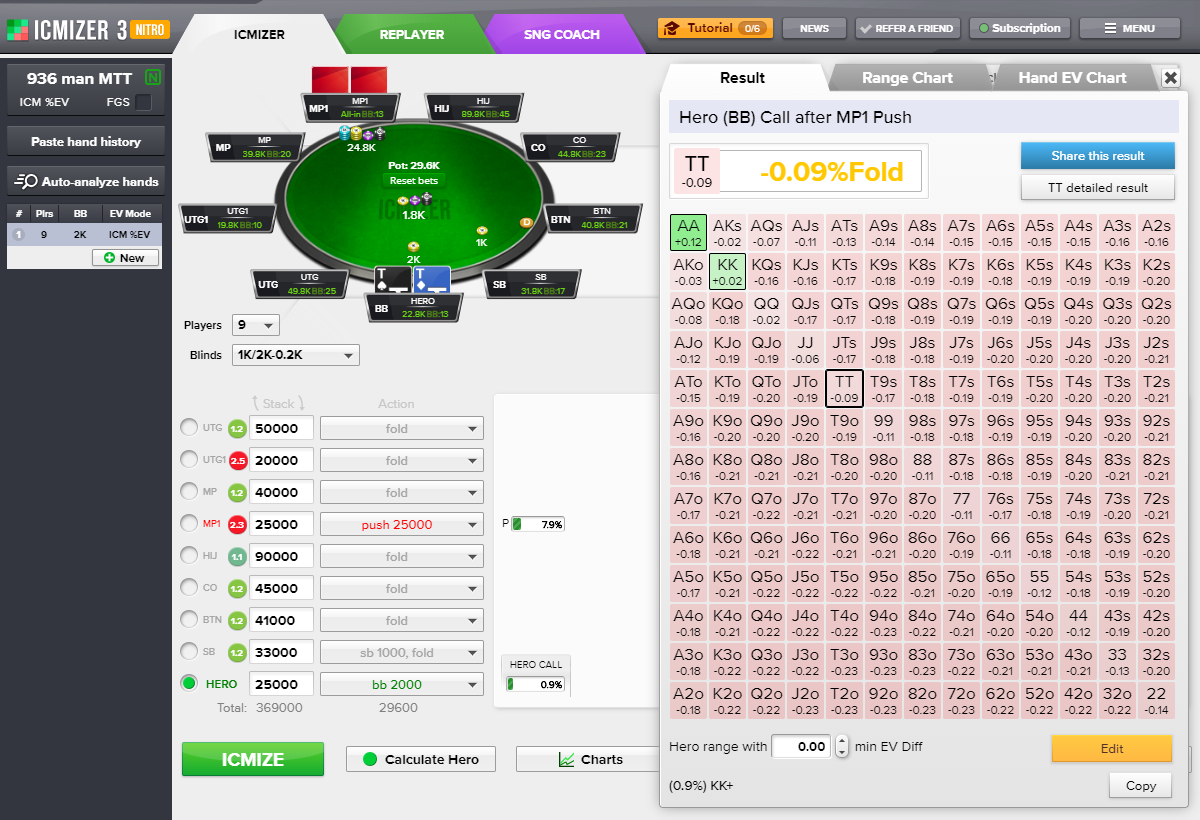
We see that the Hero’s true range for calling MP1’s push is 0.9% – not 5.7% as previously calculated, while the profit of their call is actually negative at –0.09% of the prize pool.
This ICM-based calculation result is in line with our intuitive understanding of the tournament situation. At the bubble stage, the Hero just doesn’t have enough equity to call with TT; they should better fold and keep their chances of finishing in the money.
3. Not using МТТ mode when loading a hands history from an MTT
When you load a hands history from an MTT you’ve played, you should do so using MTT mode. If you don’t, ICMIZER will assume that either your hand is being played at the final table of an MTT or in a single-table SNG.
Even if you’re only loading one or two hands from an MTT and not the whole tournament, you should still use MTT mode.
If you’ve loaded a whole MTT to analyze it automatically but you did not enable MTT mode, ICMIZER will think you’re analyzing just the final table of the tournament. It will then consider the final payouts in all hands as those of the final table, even if the hand was played at an earlier stage. And if you enable MTT mode for one of these hands, the МТТ control window will still be missing important information about the tournament for the stage in which the hand was played. This, again, can lead to misleading calculations.
Example:
We’ve loaded a tournament to automatically analyze but did not enable МТТ mode. Here is the calculation result:
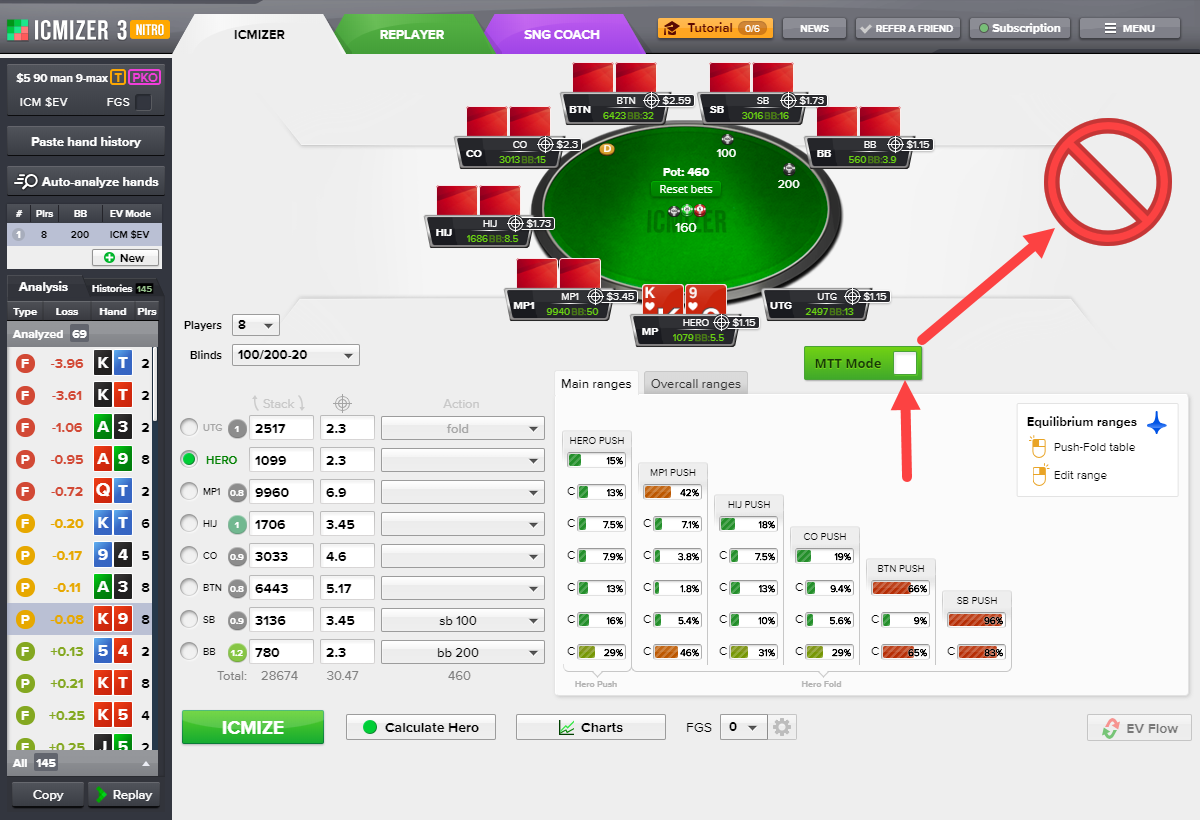
This is what happens if we enable MTT mode just for this one hand:
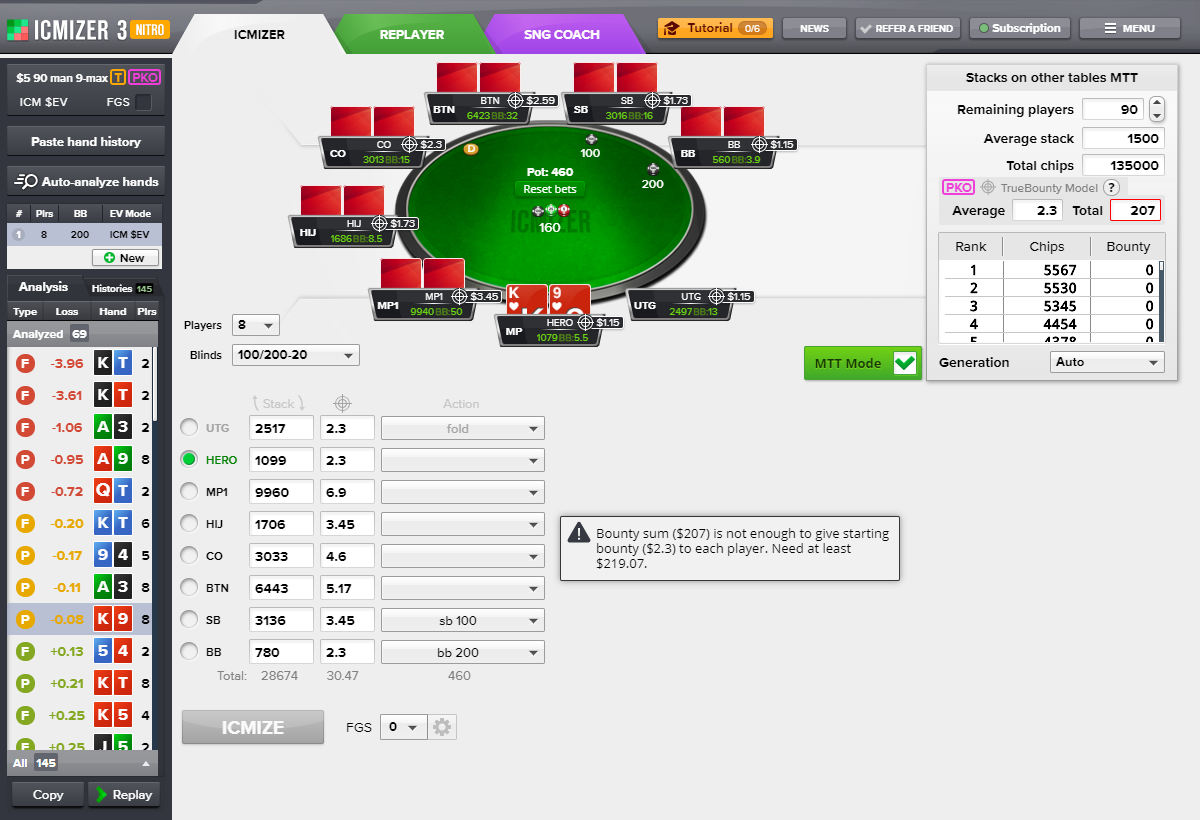
Now, if we had enabled MTT mode when loading the tournament, then each hand would have been processed based on the actual tournament stage in which it was played. The stacks of all players at the other tables would be factored in ICMIZER’s calculations.
Here is what the results would look like if we had done that:
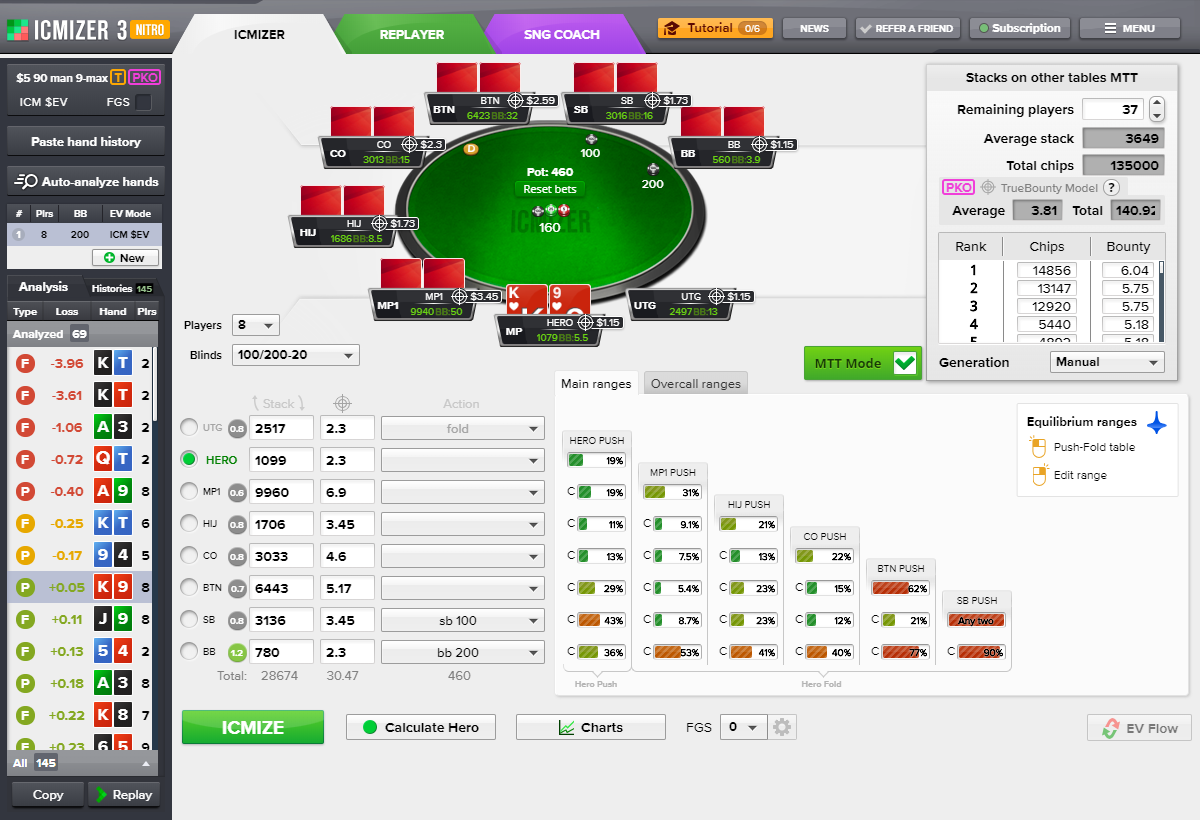
Note also that the calculations with MTT mode disabled are quite different: –$0.08 versus +$0.05 when it is enabled.
4. Misuse of МТТ mode: average stacks / bounties mismatching those at the table, or misbalanced stacks / bounties
Because МТТs are usually played out evenly, the average stack size (and the average bounty for a progressive knockout tournament) in the MTT control window should be close to the values at our table. If they aren’t, this can lead to inaccurate and abnormal calculation results.
Consider this example. There are two tables remaining in an МТТ, but all players at your table are short-stacked, while all the huge stacks are crowded at the other table. Obviously, the strategies at each table will differ drastically from what they would be in the much more common situation where the short stacks and the big stacks are more evenly divided between the last two tables.
One of the reasons for doing such calculations is described in our post “MTT ICM Calculator – How to Review MTT Bubble Hands”.
“In some cases when there are short stacks on other tables, short stacks on our table actually turn out to be medium stacks out of the remaining players, which too can influence our push or fold decision.”
The converse is true as well: when another table has some huge stacks, the stacks at our table become very short, which can lead to imbalances in the calculations.
Here’s an example:
https://www.icmpoker.com/icmizer/#sbufEc
We have loaded a tournament to be automatically analyzed but did not enable MTT mode. Accordingly, ICMIZER has no information about the starting stack, the total number of players, or the total number of chips in the tournament. Later, when we analyze different hands from this tournament and we enable MTT mode, we’re in for a surprise:
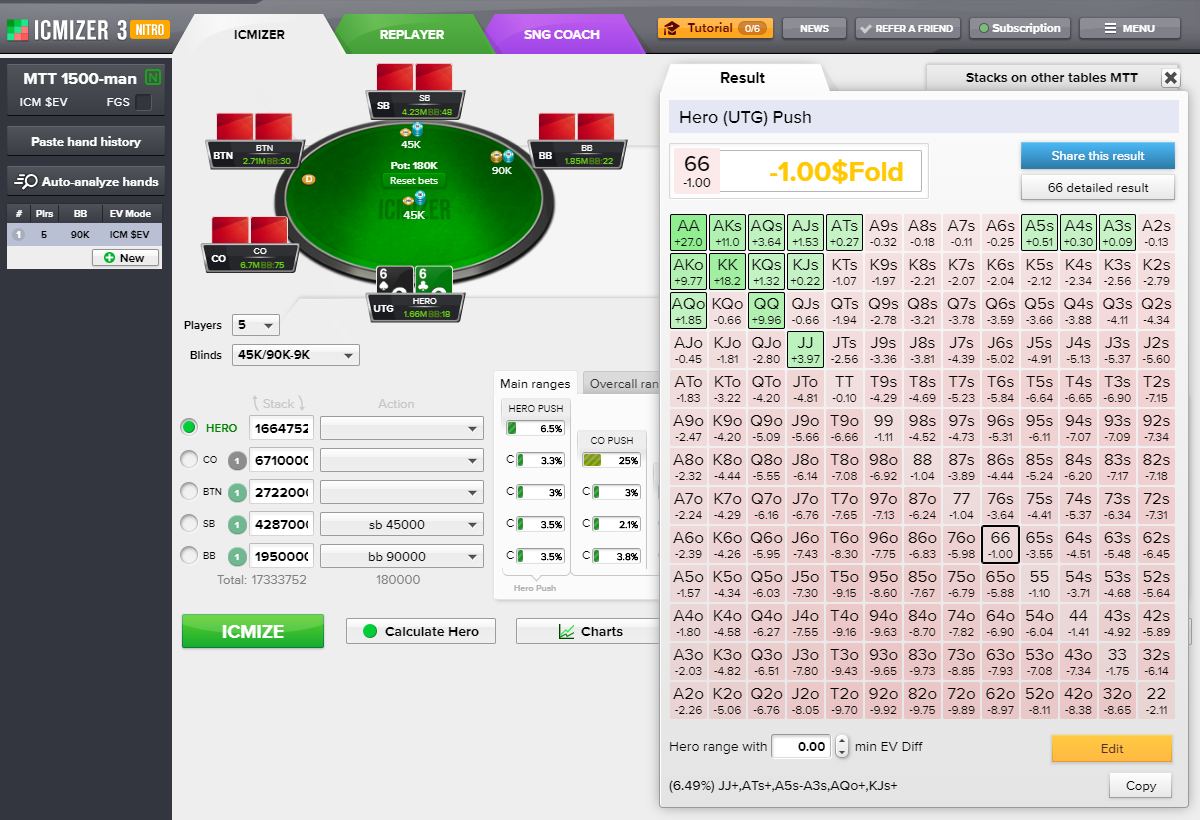
ICMIZER has constructed a very narrow push range for the Hero – 6.5%, and recommends folding their hand, 66.
Let’s check what the МТТ control window shows us:
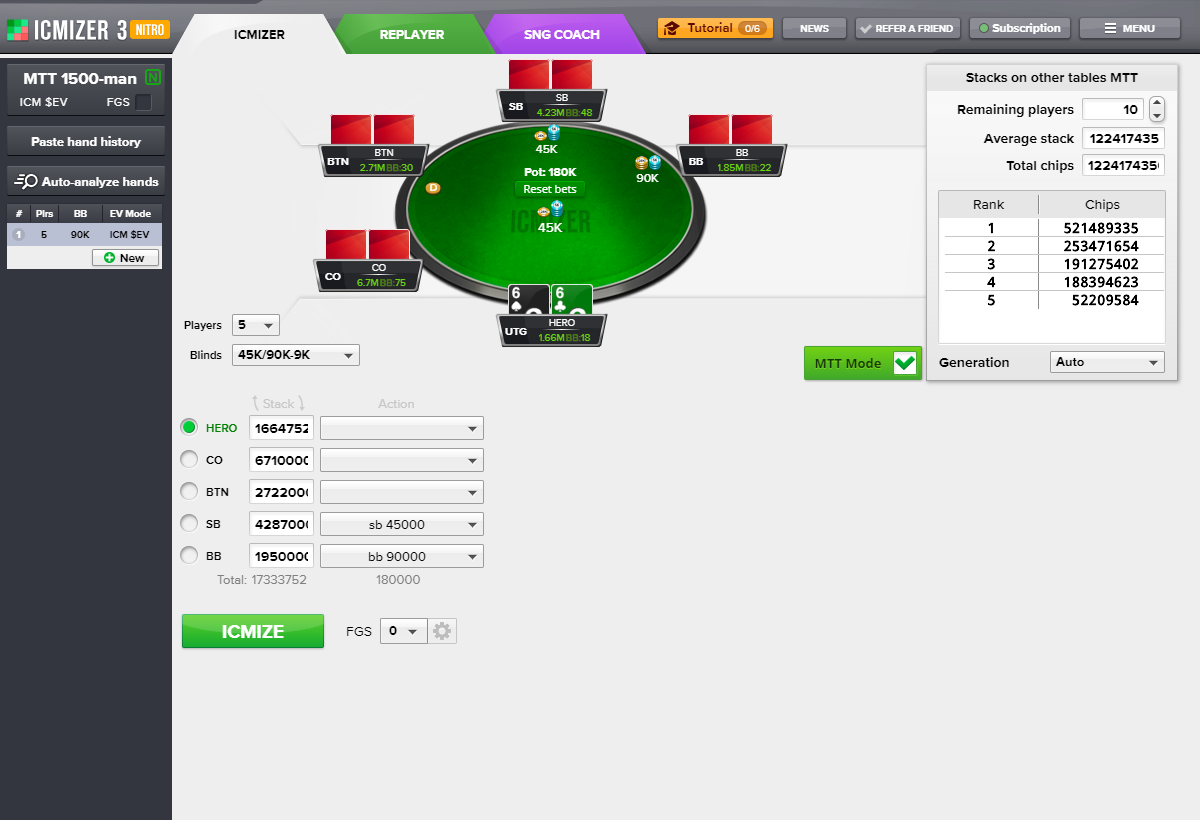
As we can see, the average stack size is 122.4M, while the average stack at the Hero’s table is only 3.4M – less than 3% of the true average!
Let’s adjust the parameters of this hand to reflect the real situation, by adjusting the average stack size in this window.
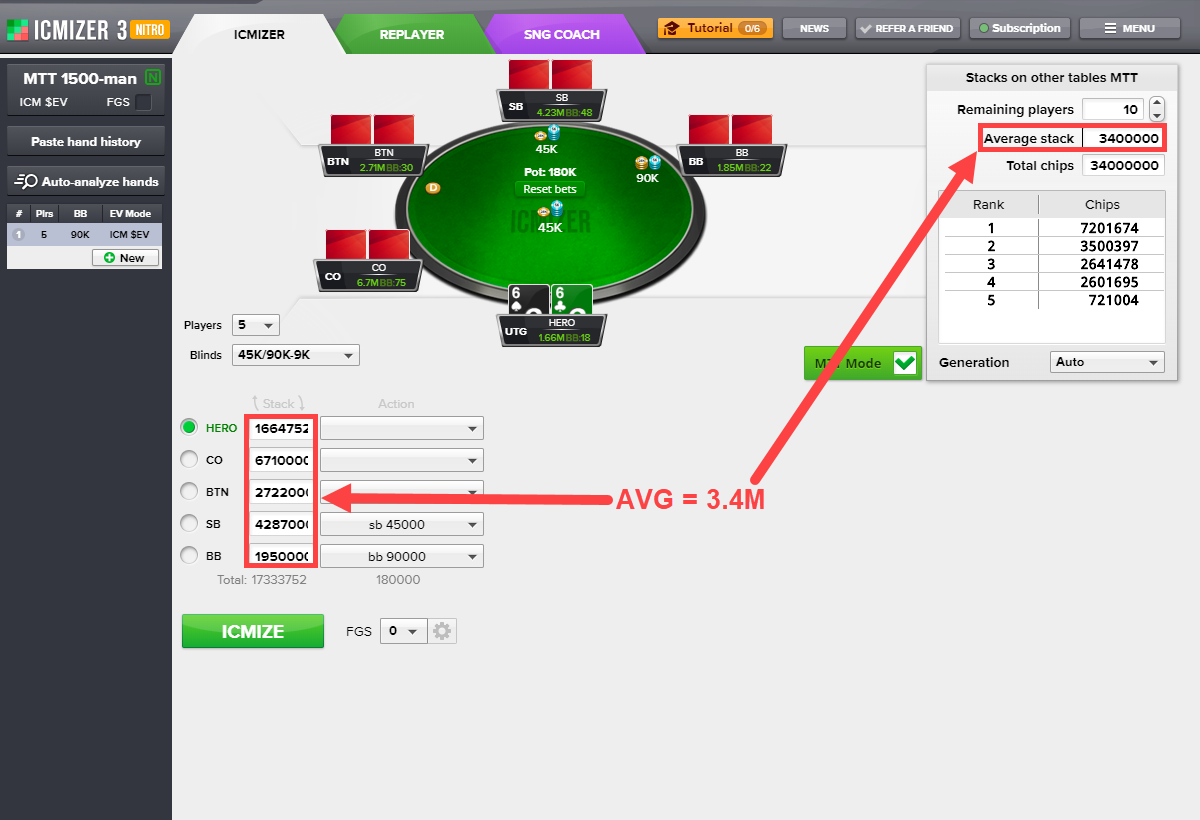
The new result we get is a lot more realistic:
https://www.icmpoker.com/icmizer/#skuPGQ
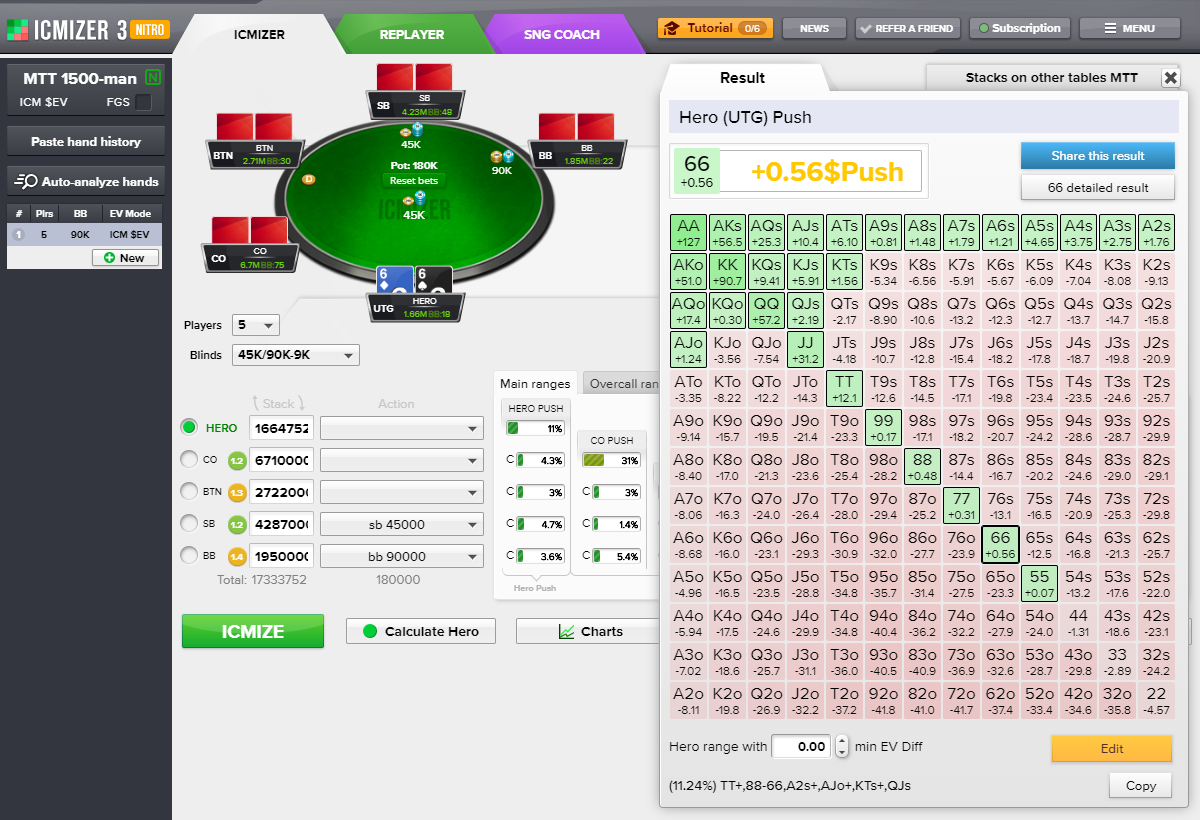
5. Misuse of MTT mode: Entering incorrect bounties
If an incomplete PKO tournament has been loaded into ICMIZER, or if the hands history from a PKO tournament is missing the bounty amounts, then you should manually enter the average bounty and the remaining knockout prize pool at the time of the hand. This can be done in the MTT control window.
https://www.icmpoker.com/icmizer/#WjKMRY
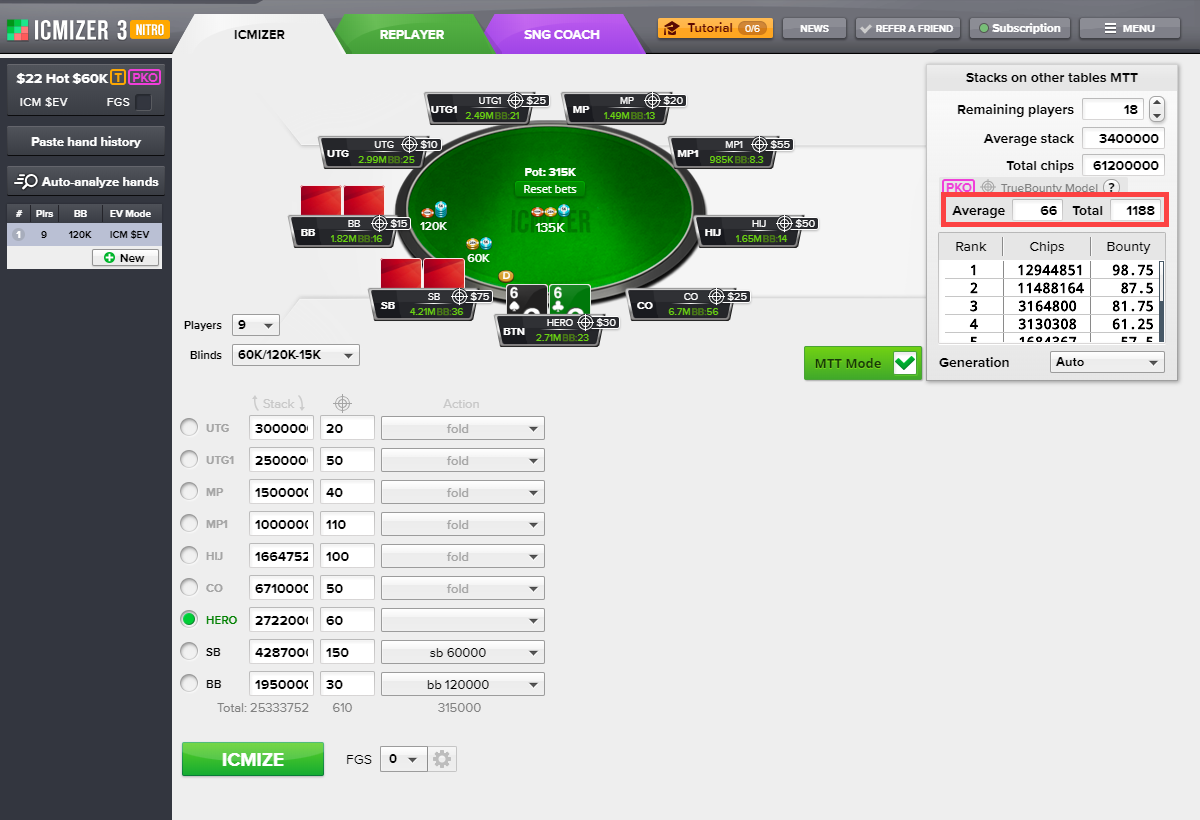
As we mentioned earlier in Pitfall #4, the average bounty in the MTT control window should be close to the average bounty in the current hand.
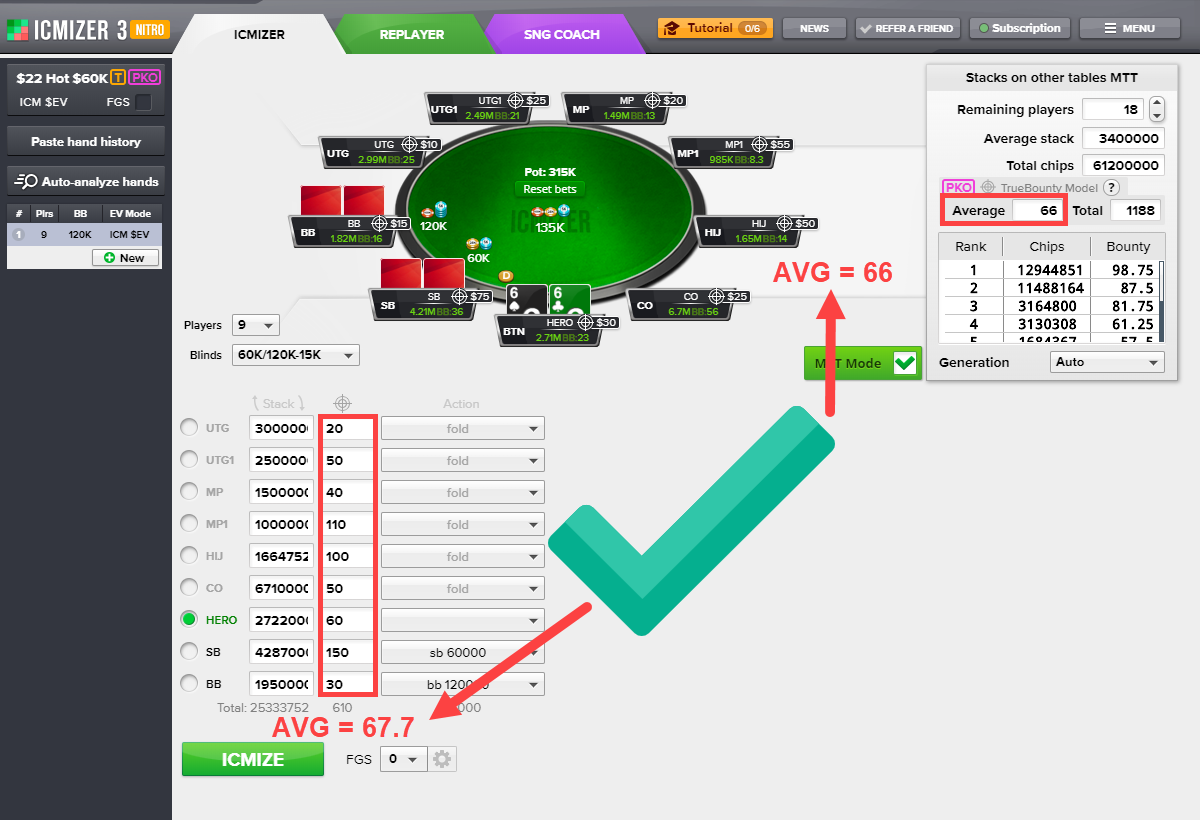
Sometimes users make the mistake of entering the total knockout prize pool in the Total box, which is actually meant for the remaining knockout prize pool at the time of the hand. "Total" bounties equal to "Remaining players" multiplied by "Average" bounty. If you enter the total instead, the average bounty amount across the tournament will increase, and that will imbalance the bounties at the current table and at the other tables.
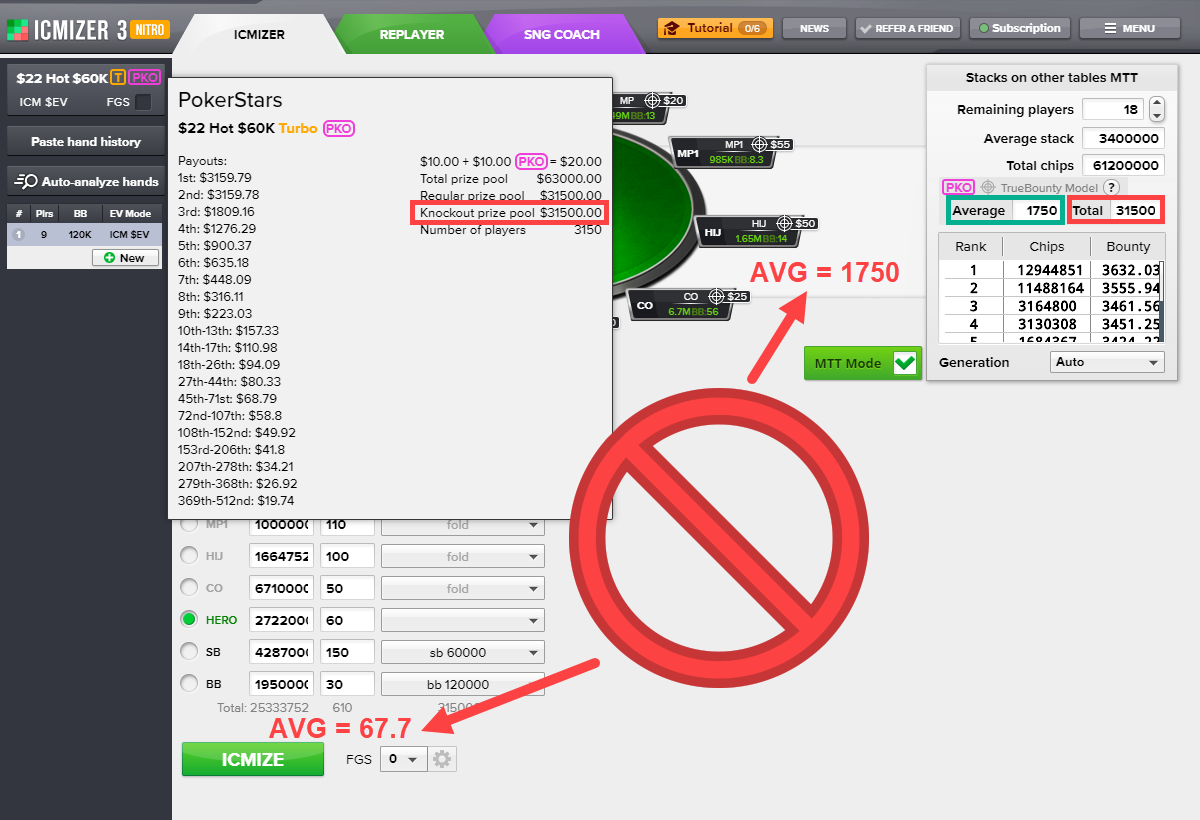
6. Not believing the results ICMIZER generates
In some situations, ICMIZER will show you unexpected results that may be hard to believe at first. Most of the time, there is a valid reason. Barring the pitfalls we’ve covered already, such unexpected results can well be explained by the specifics of the tournament structure or other parameters.
Here is an example:
https://www.icmpoker.com/icmizer/#zpXlQv
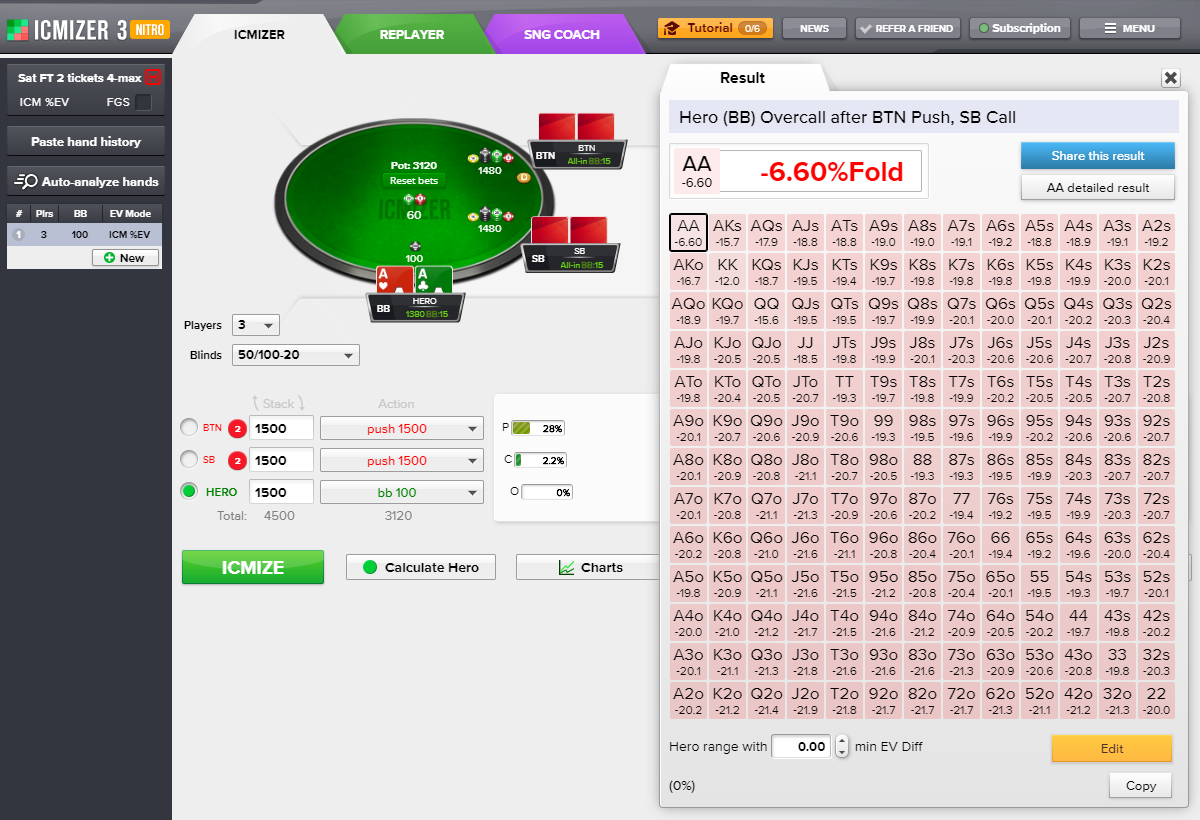
ICMIZER is advising us to fold any hand. This strange-looking recommendation is due to the tournament structure – Sat FT 2 tickets 4-max. This is a satellite tournament that finishes when two players remain, and both get the same prize regardless of their stacks. In our situation, the field is down to 3 players and 2 of them have gone all in.
According to the ICM model, which takes into account the tournament payouts, the Hero’s best strategy is to fold and watch as their opponents battle it out on the bubble. Whoever wins, the Hero will safely collect his ticket without risking coming in third. Yes, folding a hand like AA is obviously counterintuitive and it is different from the calculation you would get by using the Chip EV model, but it is the most effective strategy nonetheless.
Here is one more bizarre-looking situation – ICMIZER tells us 55 is better than 88:
https://www.icmpoker.com/icmizer/#MgWBNs
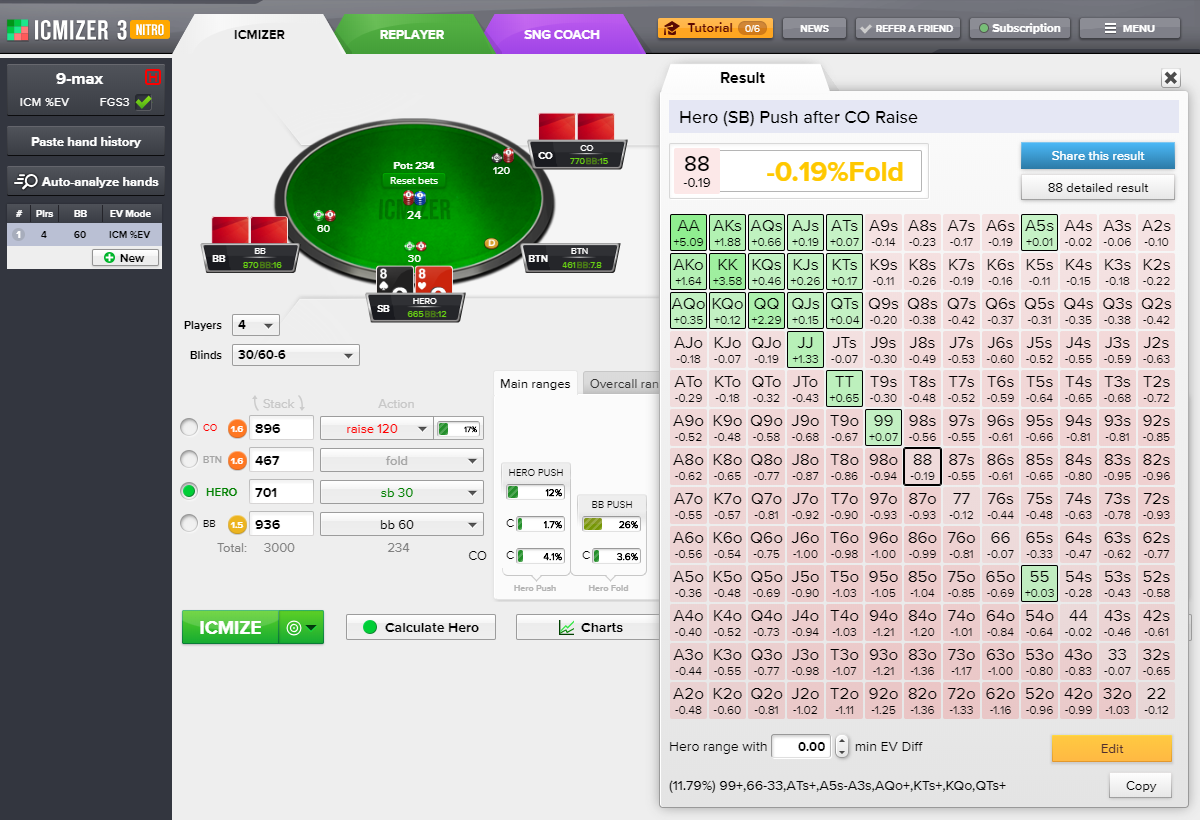
How is it possible that we should fold 88 but pushing with 55 is profitable? Let’s dig in and find out.
Here’s the hand:
9-max Hyper Sit'n'Go, payouts 50/30/20
30/60-6 blinds, 4 players at the table
CO: 896
BTN: 467
Hero (SB): 701
BB: 936
Preflop: the Hero is on the SB with 88
CO raises 120, BTN folds.
CO’s raising range is 17%:
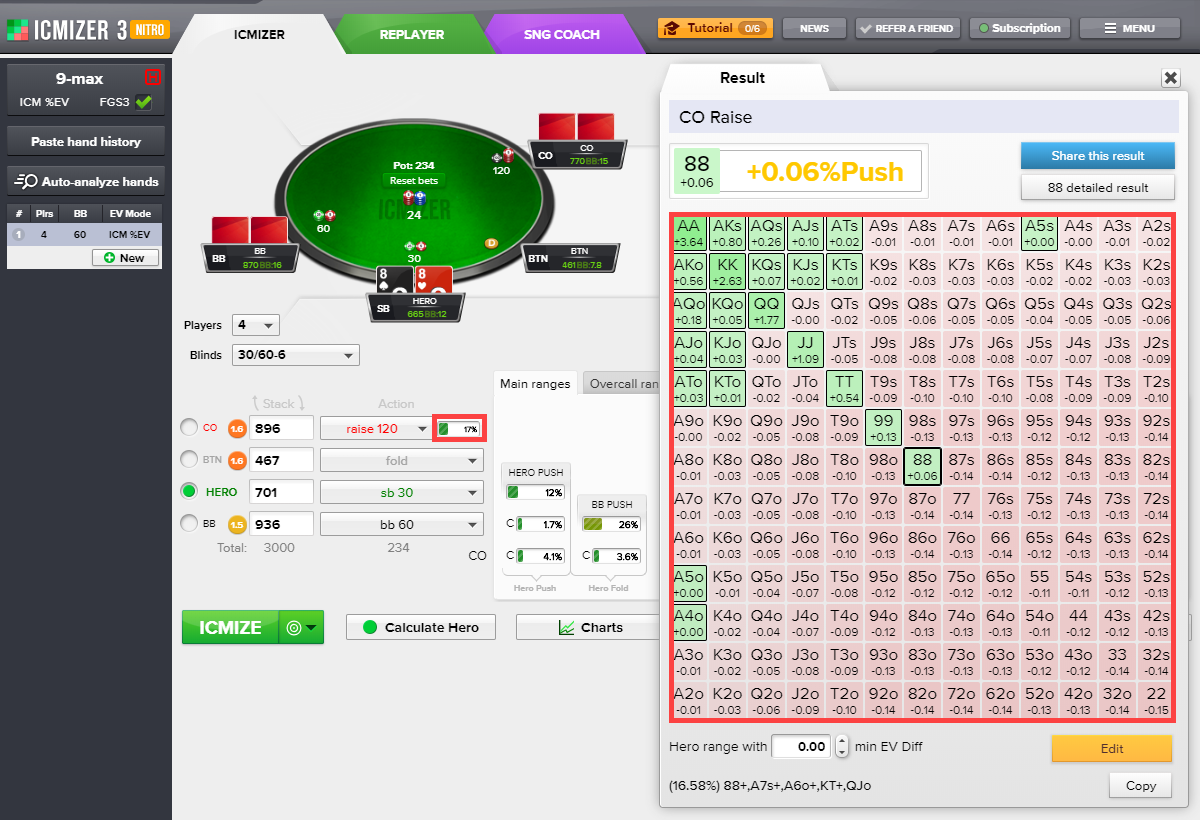
After the Hero pushes, their calling range is very strong at 4.1%:
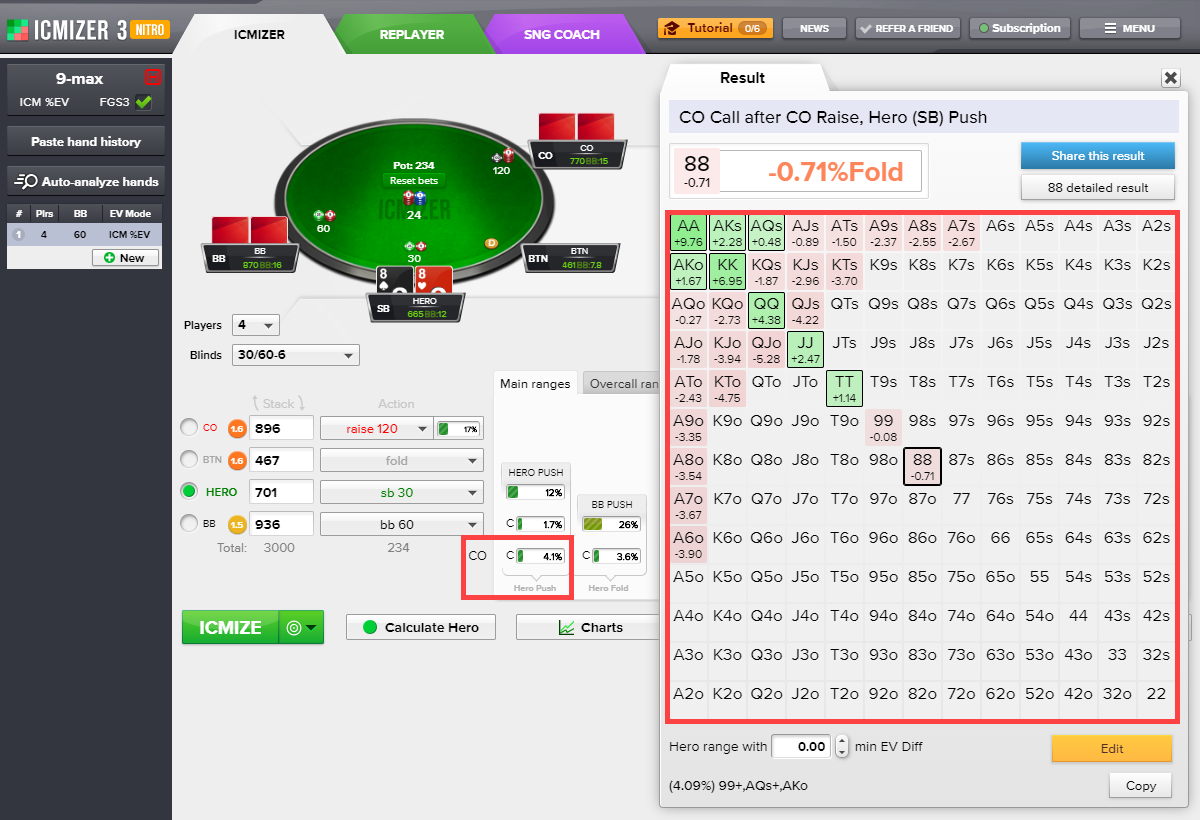
To understand what’s going on, we need to look at what factors are being considered when calculating the Hero’s pushing EV.
Let’s look into the details of the 88 hand:
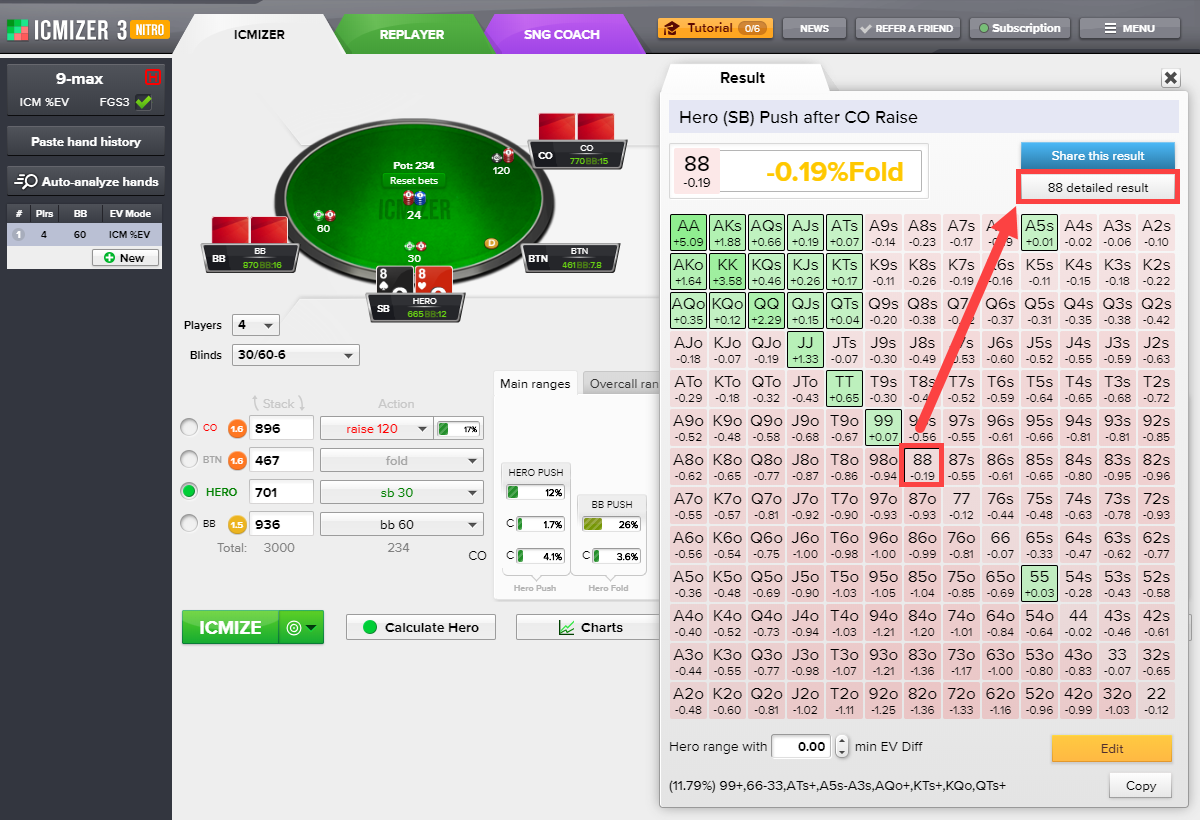
We see that when the Hero pushes, certain hand outcomes have certain probabilities.
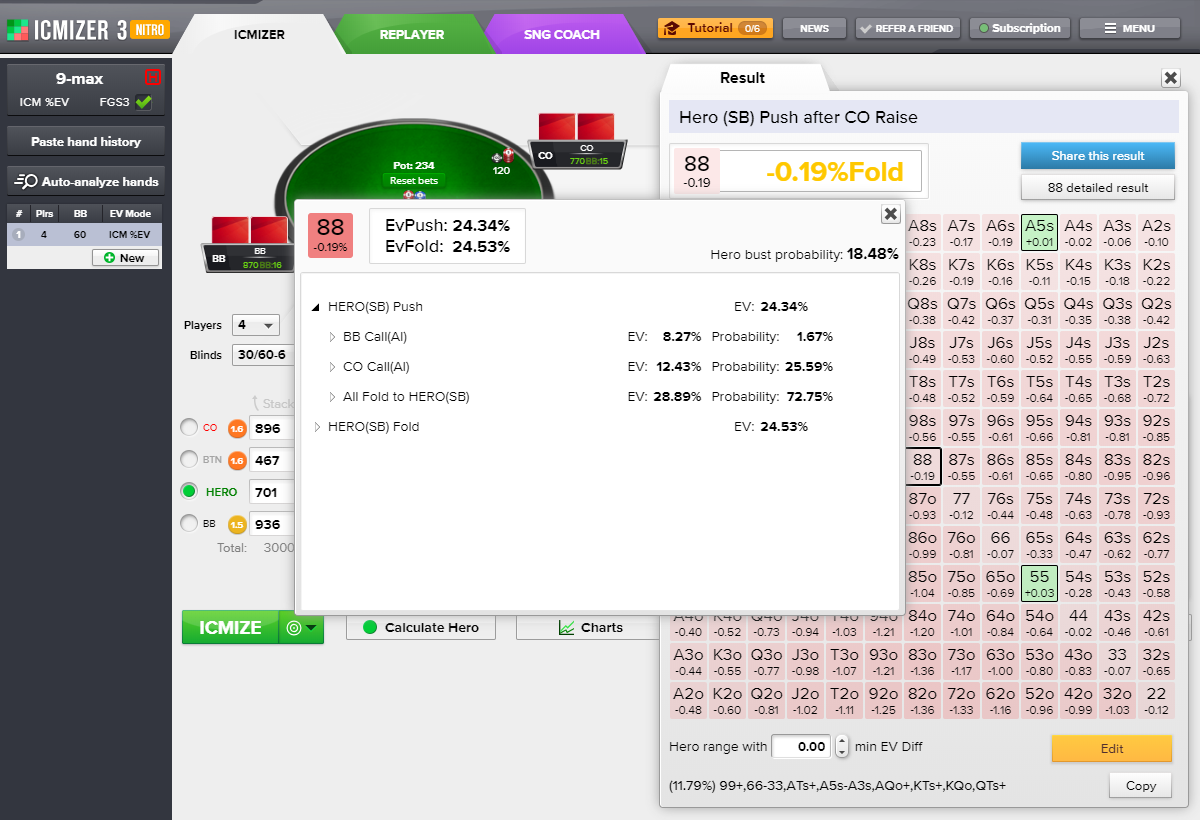
- The probability of the BB calling is 1.67%
- The probability of the CO calling is 25.59%
- The probability that everyone will fold after the Hero’s push is 72.75%
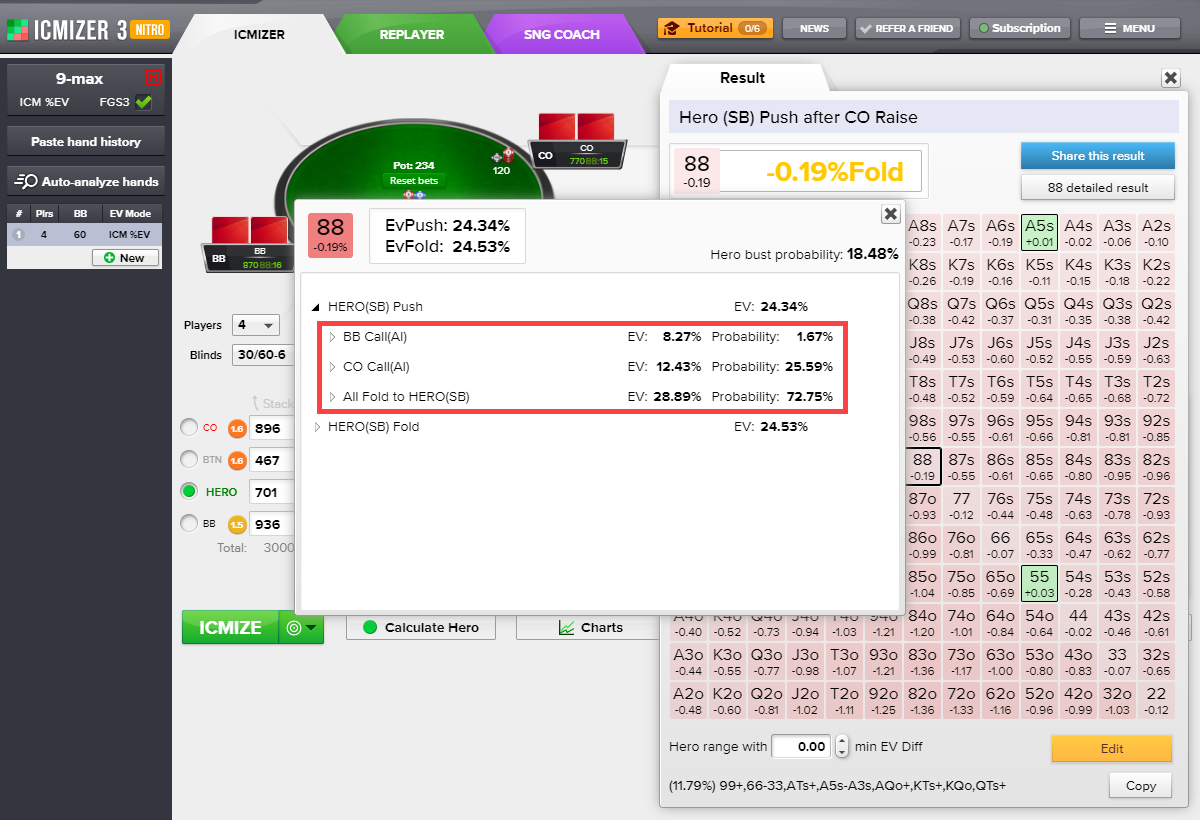
Now let’s look at the details for the 55 hand:
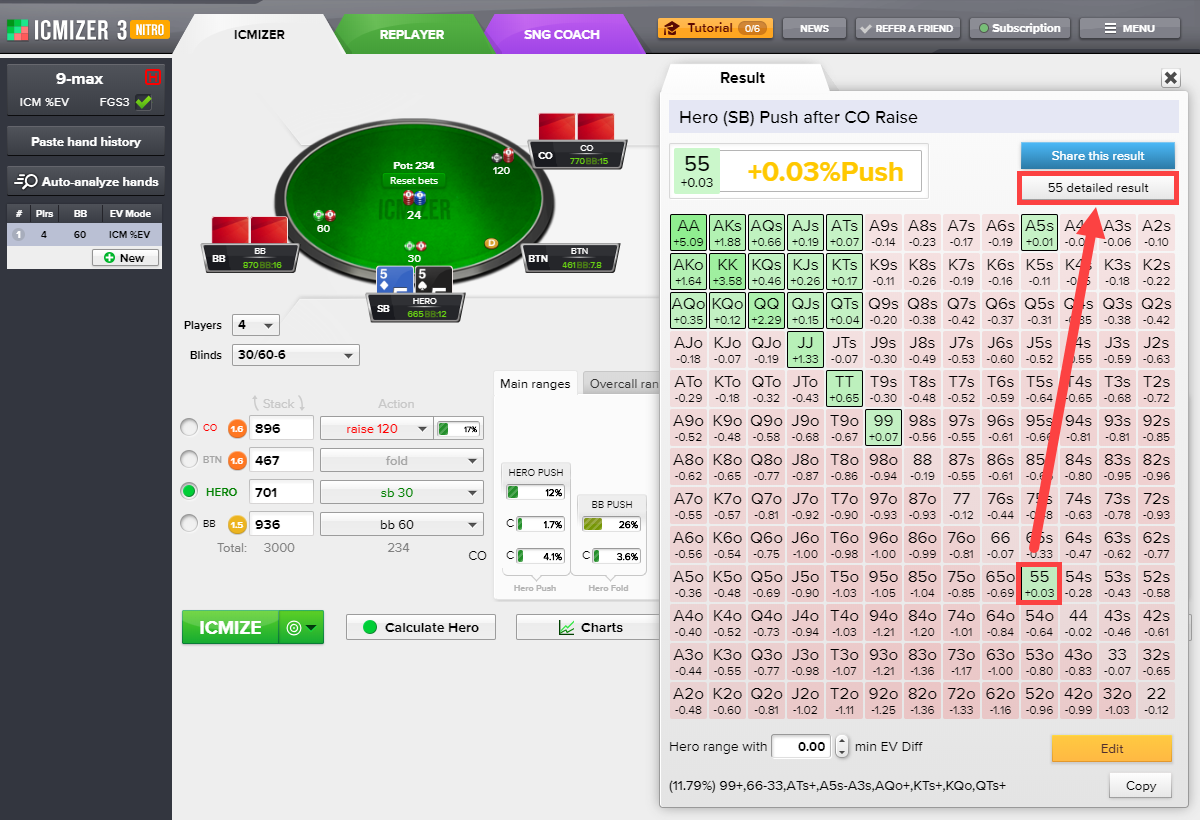
- The probability of the BB calling is 1.68%
- The probability of the CO calling is 24.25%
- The probability that everyone will fold after the Hero’s push is 74.08%
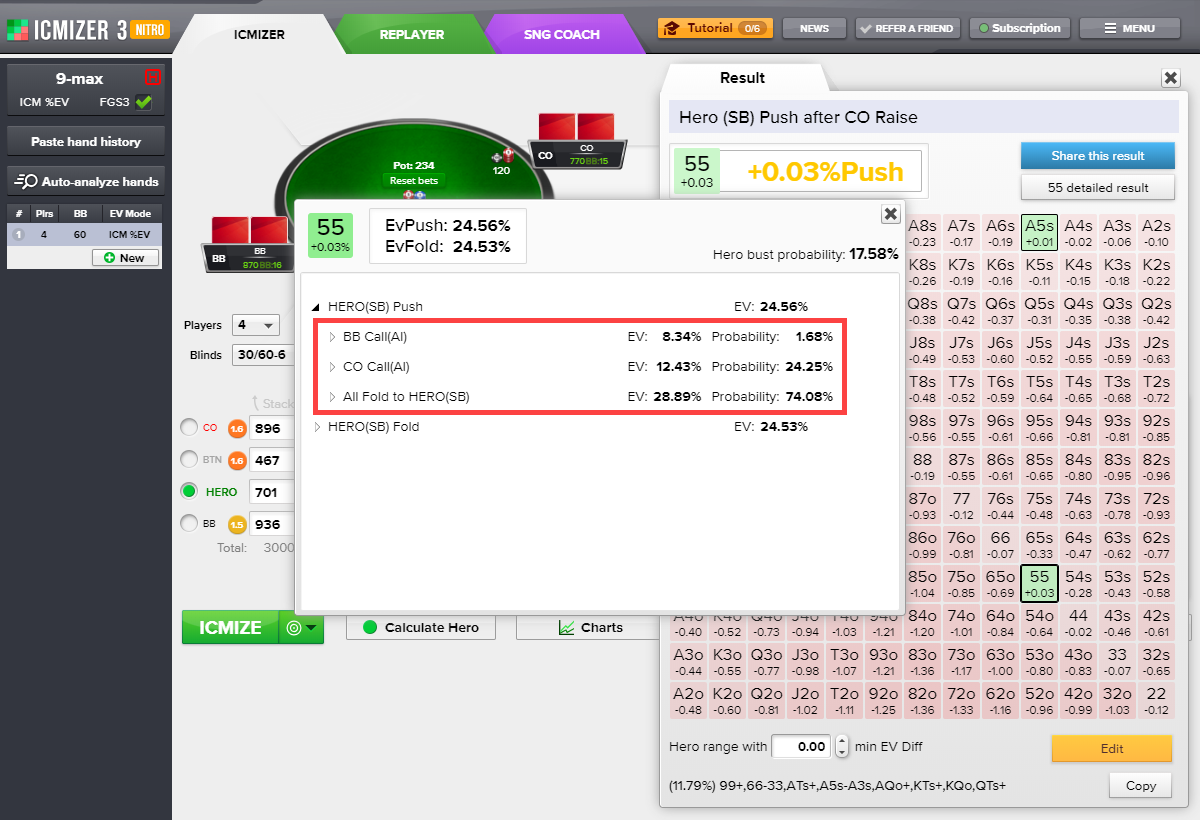
Comparing the two sets of statistics, we see that when we have 55, the CO will call less often than they would if we had 88 – 24.25% vs 25.59%. Likewise, they are more likely to fold when we have 55. Multiplying these probabilities by the respective EV, we see that the EV of the Hero’s push is 24.56% with 55, but only 24.34% with 88.
Why?
Look closely at the CO’s raising range, namely, the kinds of ace hands they open with. This range includes A6s+ and A6o+. But their calling range that includes aces only has AQs+ and AKo. In other words, the CO will likely not call with A6s-AJs or A6o-AQo. This means that if we want the CO to fold, we want them to have pocket hands like A6s-AJs or A6o-AQo. But, when we have a hand like 77 or 88, this blocks those cards for the CO that would give them weaker hands like A7-A8, and thus decreases the chances of them folding. Whereas, if we have 55, those weaker ace hands are not blocked for the CO. That is why, in this particular situation, having pocket fives is better than having pocket eights.
Let’s see what happens if we remove the weaker aces from the CO’s raising range:
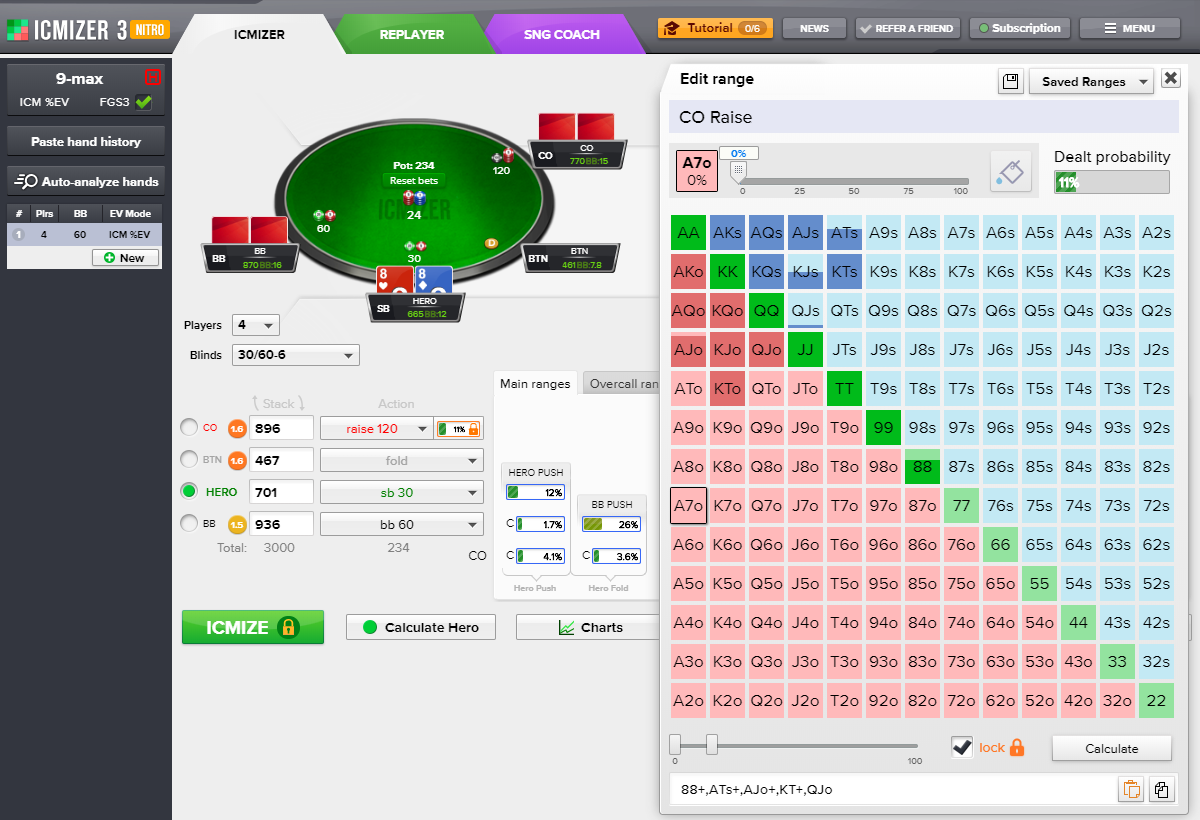
The situation has changed to resemble a normal one:
